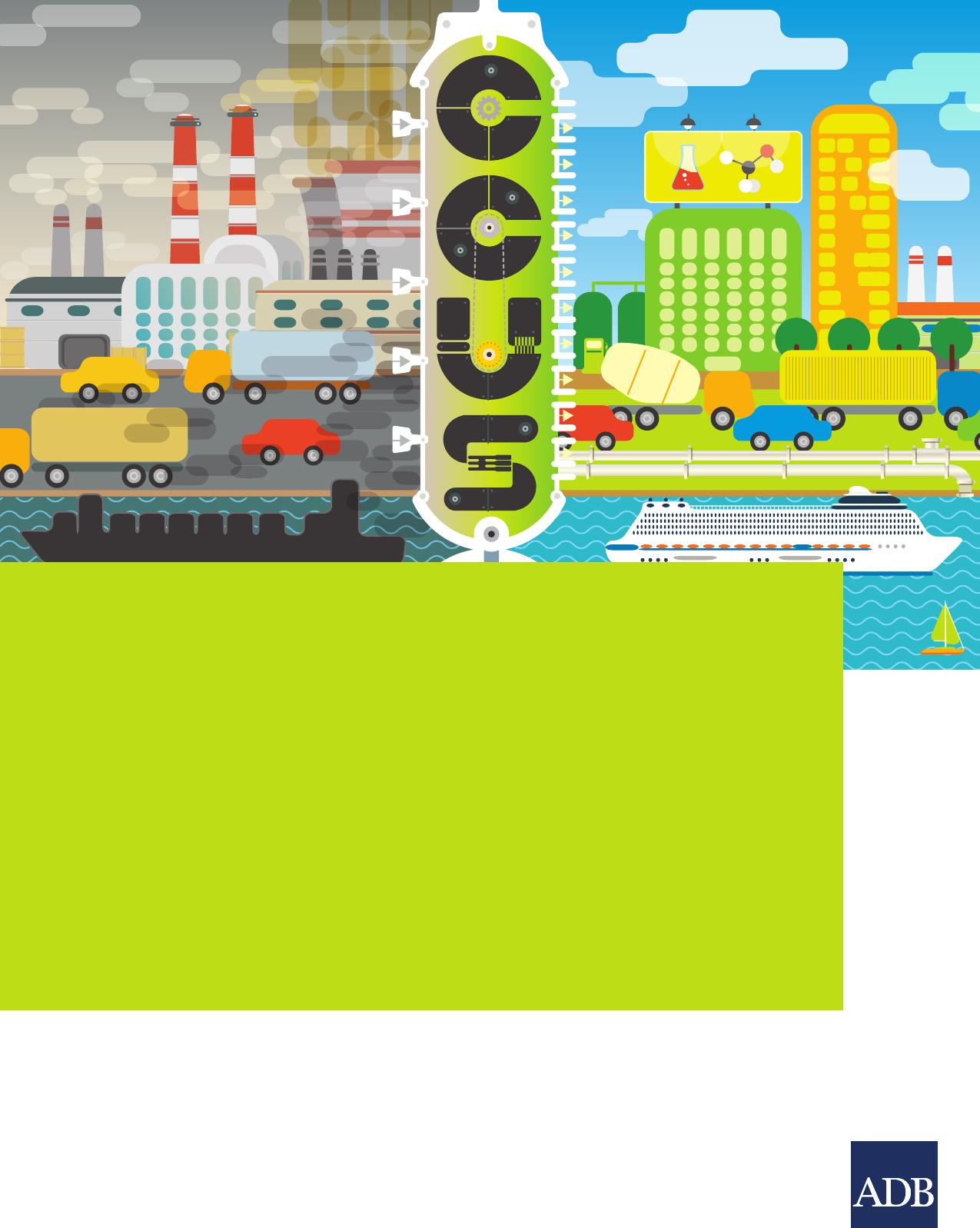ASIANDEVELOPMENTBANKCARBONCAPTURE,UTILIZATION,ANDSTORAGEGAMECHANGERSINASIAANDTHEPACIFIC2022COMPENDIUMOFTECHNOLOGIESANDENABLERSASIANDEVELOPMENTBANKCARBONCAPTURE,UTILIZATION,ANDSTORAGEGAMECHANGERSINASIAANDTHEPACIFIC2022COMPENDIUMOFTECHNOLOGIESANDENABLERSCreativeCommonsAttribution3.0IGOlicense(CCBY3.0IGO)©2023AsianDevelopmentBank6ADBAvenue,MandaluyongCity,1550MetroManila,PhilippinesTel+63286324444;Fax+63286362444www.adb.orgSomerightsreserved.PublishedinJuly2023.ISBN978-92-9270-230-4(print);978-92-9270-231-1(electronic);978-92-9270-232-8(ebook)PublicationStockNo.TCS230251-2DOI:http://dx.doi.org/10.22617/TCS230251-2TheviewsexpressedinthispublicationarethoseoftheauthorsanddonotnecessarilyreflecttheviewsandpoliciesoftheAsianDevelopmentBank(ADB)oritsBoardofGovernorsorthegovernmentstheyrepresent.ADBdoesnotguaranteetheaccuracyofthedataincludedinthispublicationandacceptsnoresponsibilityforanyconsequenceoftheiruse.ThementionofspecificcompaniesorproductsofmanufacturersdoesnotimplythattheyareendorsedorrecommendedbyADBinpreferencetoothersofasimilarnaturethatarenotmentioned.Bymakinganydesignationoforreferencetoaparticularterritoryorgeographicarea,orbyusingtheterm“country”inthispublication,ADBdoesnotintendtomakeanyjudgmentsastothelegalorotherstatusofanyterritoryorarea.ThispublicationisavailableundertheCreativeCommonsAttribution3.0IGOlicense(CCBY3.0IGO)https://creativecommons.org/licenses/by/3.0/igo/.Byusingthecontentofthispublication,youagreetobeboundbythetermsofthislicense.Forattribution,translations,adaptations,andpermissions,pleasereadtheprovisionsandtermsofuseathttps://www.adb.org/terms-use#openaccess.ThisCClicensedoesnotapplytonon-ADBcopyrightmaterialsinthispublication.Ifthematerialisattributedtoanothersource,pleasecontactthecopyrightownerorpublisherofthatsourceforpermissiontoreproduceit.ADBcannotbeheldliableforanyclaimsthatariseasaresultofyouruseofthematerial.Pleasecontactpubsmarketing@adb.orgifyouhavequestionsorcommentswithrespecttocontent,orifyouwishtoobtaincopyrightpermissionforyourintendedusethatdoesnotfallwithintheseterms,orforpermissiontousetheADBlogo.CorrigendatoADBpublicationsmaybefoundathttp://www.adb.org/publications/corrigenda.Notes:Inthispublication,“$”referstoUnitedStatesdollars,unlessotherwisestated.ADBrecognizes“Korea”astheRepublicofKorea.CoverdesignbyMikeCortes.ContentsTables,Figures,andBoxes�ivForeword�viAcknowledgments�viiAbbreviations�viiiOverview�1Game-ChangingCarbonDioxideCaptureTechnologies�3CarbonDioxideCaptureThroughHotPotassiumCarbonateAbsorption�3CarbonDioxideCapturethroughCryogenicCooling�6CarbonDioxideCapturethroughElectro-SwingAdsorption�10PartialCaptureofCarbonDioxide�13Game-ChangingCarbonDioxideUtilizationTechnologies�19UtilizationofCarbonDioxideCapturedfromWaste-to-EnergyPlantsin�19SyntheticNaturalGasProductionCarbonDioxideUtilizationinTextileDyeing�25CarbonDioxideUtilizationinAlgaeProteinandOilProduction�29CarbonDioxideUtilizationinBiogenicConstructionMaterials�31CarbonDioxideStorageinCementitiousMaterials�38Game-ChangingCarbonDioxideStorageTechnology�41TurningCarbonDioxideintoStone�41Game-ChangingCarbonDioxideCapture,Utilization,andStorageTechnologyEnabler�47EnablingCarbonDioxideRemovalsthroughCollectivePurchasingVehicle�47OtherAsianDevelopmentBankReportsonCarbonCapture,Utilization,andStorage�50Tables,Figures,andBoxesTables1Comparisonbetween90%Full-Capturevs.60%Partial-CaptureDesign�172NextGenCarbonDioxideRemovalProjectPipeline�48Figures1KarbonTechnologyHotPotassiumCarbonateCarbonCapture�42SustainableEnergySolutionsCryogenicCarbonCaptureProcessFlowDiagram�63SchematicDiagramofElectro-SwingAdsorption�104TimelinefortheDeploymentofPartialCarbonDioxideCapture�135DesignPathsforPartialCapture�146Full-Scalevs.Down-ScaledCaptureDesign�157CarbonDioxideCaptureCostSavingsfromPartialCaptureandFullCapture�168TheccWOIMACarbonCapturePlantProcess�209EnergySampoCCULiquidSyntheticNaturalGasProduction�2110EnergySampoCarbonCaptureUtilizationValueChain�2211CarbonTextileDyeingProcess�2612CarbonDioxideDyeinginaNutshell�2613ImpactTechnologyAdoptionfromLocaltoGlobal�2814GlobalAlgae’sKeyInnovationsandEnergyCostReductions�3015LignikCompositeProductionProcess�3116ProductsoftheLignikProcess�3217LignikTechnologyComparisonwithNegativeEmissionTechnologies(TrafficLightRatingSystem)�3418LignikHouseStrengthsandApplications�3419EconomicActivitySpurredbyaLignikFactory�3620CarbonUpcycling’sMechanicallyAssistedChemicalExfoliationProcess�3821CarbfixProcess�4222On-SiteCaptureandStorageDiagram�4423CodaTerminalandStorageSite�4524DirectAirCaptureandStorage�4525NextGenCarbonDioxideRemovalFacilityStructure�48Boxes1KarbonHotPotassiumCarbonateCarbonCaptureKeyFeatures�32CryogenicCarbonCaptureKeyFeatures�63VerdoxElectro-SwingAdsorptionKeyFeatures�104ChalmersUniversityofTechnologyPartialCarbonCapture�135ccWOIMACarbonCapturePlantKeyFeatures�19Tables,Figures,andBoxesv6DyeCooTextileSystemsKeyFeatures�257GlobalAlgaeInnovations’AdvancedAlgaeFarmingKeyFeatures�298LignikTechnologyKeyFeatures�319Carbon-UpcycledCementitiousMaterials�3810CarbfixKeyFeatures�4111NextGenCarbonDioxideRemovalFacilityKeyFeatures�47ForewordAstheclimatebankforAsiaandthePacific,theAsianDevelopmentBank(ADB)strivestoseeasustainablelow-carbonregioninthenexthalfofthiscentury.Whilethedestinationhasbeendecided,thepathoftechnologiesisstilluncertain.Thewinninglow-carbonsolutionwillemergeastechnologiesdevelop,experienceisgained,andfundingisdetermined.Hence,ADBhaskeptitsnear-termaswellaslong-termtechnologicaloptionsopen.Thisisthereasonwhyhydrogen;carboncapture,utilization,andstorage(CCUS);energyefficiency;renewableenergy;energystorage;andsomanyothersignificanttechnologieshavebeenpursuedsimultaneouslybyADB.CCUShasaspecialspaceamongthemanyoptionsforlow-carbondevelopmentinAsia.Ithelpsinensuringenergysecurity,decarbonizationofhard-to-abateindustries,andcompliancewithinternationalcommitments.Atthesametime,itguaranteesarelativelylowdisruptionintheexistingarrangements.However,theutilizationofcapturedcarbonisstillinarelativelynascentstage.Hence,thereisaneedtocloselytrackthedevelopmentsincarbondioxidecapture,utilization,andstorage.ThemaidencompendiumofCCUStechnologiesin2021explainedthesalientfeaturesofcutting-edgedevelopments.Thisyear,ADBisbringinganothersetofinterestingCCUStechnologies.Aswasthecaseinthefirstpublication,thisyear’scompendiumpresentsasetoftechnologiesthatareatdifferentstagesofdevelopment.Theyrangefromearly-stagelaboratoryideastofullydevelopedtechnologythatjustneedstobecommercializedatamassscale.IwouldliketotakethisopportunitytothanktheDepartmentofBusiness,EnergyandIndustrialStrategy,GovernmentoftheUnitedKingdomfortheirsupportinthispublicationthroughtheircontributiontothecarboncaptureandstoragefundofADB.IwouldalsoliketoacknowledgethetechnicaladviceprovidedbytheGlobalCCSInstitute,Australiawhilepreparingthiscompendium.ADBwillbehappytotaketheseideasforwardinitsdevelopingmembercountriesoncetheircommercialviabilityisproven.Welookforwardtohearingfromtheinvestmentcommunitytopracticingindustries.PriyanthaWijayatungaSeniorDirector,EnergySectorOfficeSectorsGroupAsianDevelopmentBankAcknowledgmentsThiscompendiumoftechnologybriefswaspreparedbytheconsultantteamfromtheAsianDevelopmentBank(ADB)underregionalTechnicalAssistance9686:IntegratedHighImpactInnovationinSustainableEnergyTechnology(Subproject2)—PrefeasibilityAnalysisforCarbonCapture,Utilization,andStorage.TheteamwassupportedbytheDepartmentofBusiness,EnergyandIndustrialStrategy,GovernmentoftheUnitedKingdom,throughtheCarbonCaptureandStorageFundundertheCleanEnergyFinancingPartnershipFacility.ThemaincontributorstothiscompendiumareCarbfixohf.(ÓlafurEinarJóhannsson);CarbonUpcyclingTechnologiesInc.(KristinSkelton);CEMEXGlobalResearchandDevelopment(DavideZampini);ChalmersUniversityofTechnology(MaximilianBiermann);DyeCoo(ErnstSiewers);CO2Tech—aCO2CRCcompany;GlobalAlgaeInnovations,Inc.(DavidHazlebeckandMarkHazlebeck);KarbonKorea(WonDongChoandJahyeKim);Southpole(PhilipMoss);SustainableEnergySolutions(OwenHart);Verdox(JonteBoysen);andWOIMAFinlandOy(HenriKinnunenandTapioGylling).TheGlobalCCSInstitute(MatthewLoughreyandNoumanMirza)providedguidanceandsupportingatheringtechnologyinformationconsideredforthiscompendium.ADB’sClimateChangeandDisasterRiskManagementDivision,ClimateChangeandSustainableDevelopmentDepartment(CCSD);EastAsiaDepartment;PacificDepartment;Procurement,Portfolio,andFinancialManagementDepartment;SouthAsiaDepartment;andtheSoutheastAsiaDepartmentreviewedandprovidedcommentsonthedraftofthiscompendium.GuidanceinthepreparationofthiscompendiumwasprovidedbyPriyanthaWijayatunga,seniordirectorandKee-YungNam,principalenergyeconomist,energysectoroffice(SG);supportedbyCharityTorregosa,seniorenergyofficer,SG;MariaDonaAliboso,operationsanalyst,SG;MarinetteGlo,operationsassistant,SG;andADBconsultantsDarshakMehtaandRemifeDeGuzman.MariaTheresaMercado,consultant(ADB);MikeCortescoverdesign;EdithCreus,typesetter;LeviRodolfoLusterio,proofreader;andLawrenceCasiraya,pageproofcheckersupportedtheeditingandlayoutofthispublication.AbbreviationsADBAsianDevelopmentBankBEIS�DepartmentofBusiness,EnergyandIndustrialStrategy(BEIS),GovernmentoftheUnitedKingdomCAPEXcapitalexpenditureCCCcryogeniccarboncaptureCCScarboncaptureandstorageCCUScarboncapture,utilization,andstorageCDRcarbondioxideremovalCO2carbondioxideCUTcarbonupcyclingtechnologiestechnologyDACSdirectaircaptureandstorageDMCdevelopingmembercountryESAelectro-swingadsorptionEUEuropeanUnionGHGgreenhousegasHPChotpotassiumcarbonateLNGliquefiednaturalgasLSNGliquidsyntheticnaturalgasMACEmechanicallyassistedchemicalexfoliationMEAmonoethanolamineMENAMiddleEastandNorthAfricaNOxnitrogenoxideOPEXoperatingexpenditureR&Dresearchanddevelopmentsc-CO2supercriticalcarbondioxideSCMsupplementarycementitiousmaterialsSESSustainableEnergySolutionsSOxsulfuroxideUSUnitedStatesvolvolumeWtEwaste-to-energyWEIGHTSANDMEASURES€euro°CdegreeCelsiusGJgigajouleGTgigatonkgkilogramKWhkilowatt-hourLliterm2squaremeterMJmegajouleMWmegawattMWthmegawattthermalNM3hnormalmetercubeperhourssecondttontCO2tonofcarbondioxideNote:“ton”refersto“metricton”equivalentto1,000kilograms.Abbreviations1Thiscompendiumofgame-changingcarboncapture,utilization,andstorage(CCUS)conceptsdealswithfourinterestingcarbondioxide(CO2)capturetechnologies,fiveCO2utilizationtechnologies,oneCO2storagetechnology,andoneenablerconcept.Thetechnologiespresentedareinvariousstagesofdevelopmentrangingfromresearchanddevelopmenttocommercialdeployment.TheconceptsincludedinthiscompendiumwerefurnishedbyCCUStechnologyprovidersandenablersthroughtheirresponsestoanemailquestionnairepreparedbytheconsultantteamoftheAsianDevelopmentBank(ADB)throughregionalTechnicalAssistance9686:IntegratedHighImpactInnovationinSustainableEnergyTechnology(Subproject2)—PrefeasibilityAnalysisforCarbonCapture,Utilization,andStorage.Thiscompendiumisnotexhaustive.Otherideasareavailableandmayalsobeaddedinthefuture.Similarly,therearelikelytobemoresuppliersofthesametechnology.ADBlooksforwardtootheropportunitiestoaddtothiscollectionofideasonCCUS,whichcouldhelpADBdevelopingmembercountriesachievelow-carbondevelopment.ThefirststepintheprocessofCCUSisthecaptureofCO2.Overtheyears,technologieshavebeendeployedandconceptualized.Justasthecompendiumof2021,whichdescribedCO2capturetechnologiesthathaveusedmembraneorhaveusednovelcentrifugetodramaticallyreducethesizeofthecaptureequipment,thisyear’scompendiumhasanothersetofinterestingtechnologiesthatcouldchangethegame.Onetechnologyisanovelnon‑amineCO2absorptiontechnology,whichclaimstobelesstoxicandmaycostaboutathirdofwhatamine-basedcaptureisexpected.AnotherideaiscapturingCO2throughapplicationofcryogenics.Thistechnologywillnotinvolvechemicalsandcouldbeefficient.ThethirdCO2capturetechnologyfeaturedinthiscompendiumisbasedonelectrochemicaladsorptionthatrequiresnoconsumablesandlessenergythandirectairCO2capturetechnologies.Inadditiontothese,whenfull-scalecaptureisnotfeasiblebecauseofsiteconditionssuchaslowavailabilityofwasteheat,partialCO2capturecouldbeanoptiontoconsiderinthenear-term.Thistechniqueislikelytoreducecapitalandoperatingcost.AsAsiaundergoesrapidurbanization,makingcitieslivablebecomesanimportantdevelopmentcriterionfortheADBdevelopingmembercountries(DMCs).Propersolidwastemanagementandsustainableenergygenerationaretwonecessitiesthataremetthroughwaste-to-energyplants.Hence,severalsuchplantsareexpectedtobesetupinAsiainthecomingyears.Whileenergygenerationandwasteeliminationarealreadyaddressedbysuchprojects,thegreenhousegas(GHG)emissionissueduetowaste-to-energyprojectscanbemetthroughCO2capture.Theparadigmshiftinwastecollectionaswellasprocessingsuggeststhatthewastewillprimarilycompriseofbiomass.Thus,CO2capturefromwaste-to-energyprojectswillbeessentiallynegativeemissionprojects.ADBhasincludedonesuchapplicationinthiscompendium.Anotherinterestingfeatureoftheprojectistheproductionoflow-carbonfuelfromthecapturedCO2.OverviewCarbonCapture,Utilization,andStorageGameChangersinAsiaandthePacific2OtherCO2usagetechnologythatthecompendiumexploresincludesatextiledyeingtechnologythatutilizessupercriticalCO2.Conventionaltextiledyeingindustryisahugeconsumerandpolluterofwater.Accordingtoanestimate,textiledyeingaccountsfor20%ofindustrialwaterpollution.1DyeingoftextilesusingsupercriticalCO2willreducethewaterusagebymorethan90%,thussignificantlyreducingwaterpollution.ThisisaperfectexampleofCO2usagecontributingtosustainabledevelopment.ApplicationofthistechnologycanleadtoahugebenefittothetextileorientedDMCsinAsialikeBangladesh,India,Indonesia,Pakistan,thePeople’sRepublicofChina,Thailand,andVietNam.CO2inalgaefarmingisanotherpracticalutilizationofCO2includedinthiscompendium.Asillustratedinthiscompendium,advancesincommercialalgaecultivationusingwasteCO2canresultinsavingsinenergyandresourcesintheproductionofproteinforfeeds,andoilforfuelandpolymerproduction.Anotherearly-stageCO2technologyinvolvestheuseofcapturedCO2tomakebuildingmaterialsthatcouldsubstituteforsteel,cement,andwood.RapidlygrowingAsiawilllikelyexperienceahugeconstructionboom.ThismaterialwillhelpnotonlyabsorbCO2butalsohelpreducetheproductionofmaterialsthatcontributetomorethan10%ofglobalGHGemissions.1R.Kant.2012.Textiledyeingindustry:Anenvironmentalhazard.NaturalScience.4(1):p.23.AlsointroducedinthiscompendiumistheupcyclingofinorganicfeedstocksintoenhancedmaterialsthroughmineralizationwithCO2.ThetechnologyreducesthecarbonfootprintofconcretebypermanentlystoringCO2andproducingaprice-competitivesubstituteforcement.MimickingandacceleratingthenaturalprocessofCO2storageintobasaltrockformationsisanothernovelCO2storagetechnologyshowcasedhere.Thetechnology’spilotprojectdemonstratedthatcarbonatingwaterwithcapturedCO2andinjectingitintobasaltrockformationscanmineralizeCO2within2yearswhichiswayfasterthanthenaturalprocess.CO2storageinrockformationsalsohasstoragepotentialthatisgreaterthantheemissionsoftheburningofallfossilfuelsonEarth.Whilethe2021compendiumincludedCO2hubsasoneoftheenablers,thisyear’scompendiumincludedaplatformwherecarboncreditsareusedtocreateafinancialtooltoincentivizeGHGsavingsthroughtheuseofCO2removals.Consideringtheprogressintheclimatenegotiations,financingtheCCUSthroughthecarbonmarketsisarealitythatneedstobekeptinmind.Game-ChangingCarbonDioxideCaptureTechnologies3CarbonDioxideCapturethroughHotPotassiumCarbonateAbsorptionTechnologyproviderKarbonCCSLimited(RepublicofKorea;Norway)TechnologydescriptionHotpotassiumcarbonate(HPC)isawell-establishedprocessforextractingcarbondioxide(CO2)frommixedgasessuchastowngas,ammonia,hydrogen,naturalgas,andethyleneoxide.Itisusedinthousandsofindustrialfacilitiesworldwide.However,conventionalHPCprocessesareinefficientwhentheconcentrationofCO2inthemixedgasislow,at5%–30%.Althoughefficiencycanbeincreasedbypressurizingexhaustgasto10–15bar,mechanicalcompressorsaretoobulkyandexpensive.ThekeyinnovationofKarbonTechnologyeliminatestheneedforbulkyandexpensivemechanicalcompressors.KarbonTechnologypressurizesindustrialexhaustgasbycombustingittogetherwithnaturalgasandairinthecombustionchamberofagasturbine.Theresultingsecondaryexhaustgasexitsthegasturbineat10–15bar,apressureatwhichtheHPCprocessefficientlyextractsCO2.Thekeyabsorbent—potassiumcarbonate—isinert,nontoxic,inexpensive,environmentallybenign,andhasasmallfootprint.Figure1illustratesKarbon’sHPCcarboncaptureprocess.2Amineprocessesuse3–4GJpertonofCO2captured.3Subjecttocostofenergy.TechnologyadvantagesKeytechnologyadvantagesofKarbonHPCcarboncaptureprocessincludesthefollowing:(i)KarbonHPCprocesshasanenergypenaltyof2.5~3.5gigajoules(GJ)pertonofCO2captureddependingontheCO2concentrationinfluegas.2(ii)CostofCO2capturewithKarboncouldbeaslowas$30pertonofCO2captured.3Game-ChangingCarbonDioxideCaptureTechnologiesBox1:KarbonHotPotassiumCarbonateCarbonCaptureKeyFeaturesTechnologyHighlights•90%–95%ofcarbondioxide(CO2)fromexhaustgas•Costofcapturecouldbeaslowas$30pertonofCO2captured•Usesaslowas2gigajoulesofenergypertonofCO2captured•Usesinert,inexpensiveandenvironmentallybenignCO2absorbent•WiderangeofapplicationDevelopmentStage•PilotdemonstrationSectorsofApplication•Processindustries•Powerplants•MaritimeCarbonCapture,Utilization,andStorageGameChangersinAsiaandthePacific4(iii)Karboncandecarbonizefluegasfromboilers,reciprocatingenginesandgasturbinesrangingfrom2megawatts(MW)andupwardto1,000MWonlandandsea.(iv)Karboncapturesbetween90%–95%ofCO2fromexhaustgas.Theactualpercentagecapturedisadesignchoice,whichdependsontherequirementsandeconomicsofthefacilityinquestion.(v)AllcomponentsofKarbonTechnologyareoff-the-shelfandindustriallymature.Constructioncouldbesimpleandfastwithuseofstandardcomponents.(vi)KarbonusespotassiumcarbonateasCO2absorbent,whichisinert,nontoxic,andrequiresnoreplacementovertime.(vii)Karbon,operatingunderhigh-pressureatmosphere,requiresabout1/3rdlesslandcomparedtoothertechnologiesoperatingatlowpressure.Beingretrofittechnology,Karboncanalsobeinstalledadjacenttothehostplantwithoutanyinterruptiontoitsoperation.(viii)Otherpollutantssuchassulfuroxides(SOx),particulatematter,nitrogenoxides(NOx),carbonmonoxide,andmercurycanberemovedinserieswiththeKarbonprocess.Relatedcosts(i)UpfrontinvestmentforKarbonplantscapturingCO2fromcoal-firedpowerplants:(a)�$350million–Capture1milliontonsofCO2peryear(b)�$1,000million–Capture95%ofCO2froma1,000MWpowerplant(ii)Operatingcosts—Lessthan$3pertonofCO2captured,excludingthecostofnaturalgas,whichvariesbylocationandtransportcostofCO2IntheUnitedStates(US),fora1,000MWcoal-firedpowerplant,thecostofnaturalgasiscurrentlyabout$25pertonofCO2captured.(iii)Unitcosts—All-incostincludingcapitalcostisaslowas$40pertonofCO2.PotentialapplicationinAsiaandtheworld(i)Addressablemarket.By2100,climategoalswillrequireupto100gigatons(GT)ofCO2tobesequesteredperyear.Ataconservativecarbonpriceof$20perton,thisrepresentsamarketof$2trillion.(ii)Industrialsector.KarbonTechnologycapturesCO2fromexhaustgasesemittedpowerplants,steelmills,cementfactories,petrochemicalplants.(iii)Shippingsector.KarbonMarinecapturesCO2,NOxandmethaneslipfrompiston-basedFigure1:KarbonTechnologyHotPotassiumCarbonateCarbonCaptureHostPlantCapturePlantExhaustGasDivertedtotheCapturePlantNaturalgasTurbineHPCUnitExhaustGasCOFossilFuelPressurizedGasTreatedGasCO2=carbondioxide,HPC=hotpotassiumcarbonate.Source:Karbon.Game-ChangingCarbonDioxideCaptureTechnologies5shipenginesandsmallpowerplants.Itisafarlessexpensivedecarbonizationsolutionthanswitchingfuels,whichtheshippingindustryisactivelyconsidering.Statusandnextsteps(i)SiemensEnergy.KarbonisincloseconsultationwithSiemensEnergyregardingturbinesforCO2capture.SiemensEnergyperformedfull-scaletests,combustingnaturalgaswithfluegas.SiemensEnergyisnowperformingthefinaldetailedengineeringofSiemen’sSGTturbinestothespecificationsofKarbon.(ii)RepublicofKorea.KarbonformedaconsortiumtobidtoinstallaKarbonplantataliquefiednaturalgas(LNG)powerplantownedbyKEPCO,tocaptureCO2forstoragefromanearbydepletedgasfield.Challengesinscale-upanddeploymentThemainchallengeistobringtogetherthevariouspartiesnecessaryforcommercialviability,particularlytheoff-takerofCO2,forindustrialuses,orforgovernment-subsidizedsequestration,aswellasawillingengineering,procurement,andconstructioncontractor.Karbon’sfocusisoncommercialization,whichwillaccelerateoncesomekeyengineering,procurement,andconstructionconsortiummemberhascompleteditsdetailedengineering.TechnologyproviderbackgroundKarbonspecializesinextraction,transport,infrastructure,andtradingofCO2.ItsKarbonTechnologyisalow-costmethodofextractinghigh-qualityCO2fromfluegasesonanindustrialscale,removingsubstantiallyallCO2andotherpollutants,includingSOx,methane,andparticulatematter.ItwasinventedanddevelopedbyKarbon’sprincipals.AlthoughKarbonCCSLtdwasestablishedin2016,thetechnologyhasbeenindevelopmentforover20years.Karboniscommercializingglobally,notablywithcaptureplantsunderdevelopmentatcoal-firedpowerplantsintheUS.KarbonhasalsodevelopedashipborneversionoftheKarbonTechnologyfortheshippingindustry,whichisunderheavypressuretoreduceGHGemission.AsCO2willbecomeagloballytradedcommoditytransportedbyship,Karbonhavedesignedadual-cargolong-distanceLNG-CO2carriertodeliverLNGononelegofavoyageandCO2ontheother.FurtherreadingF.Levihn,L.Linde,K.Gustafsson,andE.Dahlen.2019.IntroducingBECCSthroughHPCtotheresearchagenda:ThecaseofcombinedheatandpowerinStockholm.EnergyReports5:pp.1381–1389.https://www.sciencedirect.com/science/article/pii/S2352484719301829.CarbonCapture,Utilization,andStorageGameChangersinAsiaandthePacific6CarbonDioxideCapturethroughCryogenicCoolingTechnologyproviderSustainableEnergySolutions,aChartIndustriesCompany,UnitedStatesTechnologydescriptionCryogenicCarbonCaptureinvolvesthefollowingsteps,asillustratedinFigure2.(i)Theexhaustgas(stream1)coolstonear0°Cindirectcontactheatexchangers,whichcondensesmostofthewater.(ii)Ablowerprovidespressureforprocesspressuredrop.(iii)Amole-sievedryerremovestheremainingmoisture.(iv)Theexhaustgasproceedsthroughamulti-streamheatexchangerwhereitcoolstonearthefrostpoint,thepointatwhichtheCO2beginstodesublimate.(v)Thiscoldexhaustgas(stream2)entersthepatenteddesublimatingheatexchanger,whereCO2desublimatesontocounter-flowingliquiddropletsformedfromstream3,separatingtheFigure2:SustainableEnergySolutionsCryogenicCarbonCaptureProcessFlowDiagramDISTILLATIONSYSTEMREFRIGERANTLOOPIIREFRIGERANTLOOPIFLUEGASCLEANFLUEGASCONTACTLIQUID/SUSPENSIONMIXEDREFRIGERANTIMIXEDREFRIGERANTIICOMULTI-STREAMHEATEXCHANGERDESUBLIMATINGHEATEXCHANGERCONTACTLIQUIDCOOLERCONTACTLIQUIDPUMPFUELGASCOOLINGTOWERFLUEGASCLEANFLUEGASBLOWERDRYERSOLID–LIQUIDSEPARATORCOPUMPCOPUMPCOPRODUCTMELTERCO2=carbondioxide.Source:SustainableEnergySolutions.Box2:CryogenicCarbonCaptureKeyFeaturesTechnologyHighlights•Highpurity(>99.9%)liquidcarbondioxideproduct•30%–60%lowerenergyconsumptionDevelopmentStage•PilotdemonstrationSectorsofApplication•Powerproduction—coal,naturalgas,andbiofuels•Cementandsimilarkilns•Steel•Industrialboilers•RefineriesGame-ChangingCarbonDioxideCaptureTechnologies7CO2asacondensedphasefromtheremaininglightgas.(vi)Theremainingcoldlightgaseswarmbacktoambienttemperaturethroughthemulti-streamheatexchanger,wheretheyhelpcooltheincominggas,andthelightgasesleavethesystem(stream6).(vii)ThesuspendedCO2solidsseparatefromthecoldliquidacrossabarrierfilteranddropintoaseparatechamberwheretheymeltunderpressuretoformaCO2liquid.(viii)ThisliquidCO2(stream4)entersadistillationsystemthatseparatesremainingimpuritiestoproduceahigh-pressureliquidCO2product(stream5)atambienttemperatureandveryhighpurity(>99.9%).(ix)Thecoolingfortheprocessisprovidedbytworefrigerationloopsthatexchangeheatwiththecoldcontactliquidthatisusedinthedesublimatingheatexchanger.SustainableEnergySolutions(SES)iscurrentlytestingimprovementstothecryogeniccarboncapture(CCC)process.Theseadvancedmethodsandunitoperationsimproveenergyefficiency,decreasecapitalcosts,simplifytheprocess,andincreaseprocessreliability.TechnologyadvantagesTheadvantagesofCCCcomparedtoleadingalternativecarboncapturetechnologies(e.g.,amine-basedcapturetechnologies)include:(i)Achieveshighcapturerates,uptocapturingalloftheprocess-generatedCO2andsomeoftheCO2enteringtheprocesswiththeair,withelectricityrequirementsthatarehalfofpublishedalternatives,dependingonscale,gascomposition,andotherplantspecifics;(ii)Consumes30%–60%lowerenergy;(iii)Haslowercapitalandoperatingcosts;(iv)Generatessmallerfootprint;(v)RobustlyhandlesNOX,SOX,mercury,andotherpollutants;(vi)Enablesefficientandcost-effectivegridscaleenergystorageaddressingthelargestchallengeswithsomerenewablesandloadleveling;(vii)Recoversasignificantamountofusablewaterfromgasstreams,requiringminimalwaterforoperation;(viii)RetrofitsanystationarysourceofCO2(powerplants,industrialplants,chemicalplants,etc.)withoutnewsteamgeneratorsorupstreamprocessmodification;and(ix)Builtaroundequipmentfamiliartopowerandindustrialcustomers(e.g.,refrigerationsystems,heatexchangers,processingvessels)withnotoxicchemicalemissions.PotentialapplicationinAsiaandtheworldCCCcanbeappliedinCO2-emittingsourcesincludingpowerproduction(coal,naturalgas,biofuels,wasteincineration,etc.),kilns(cement,refractory,glass,etc.),industrialboilers,andrefineries.TheCCCprocesscancaptureCO2fromsmallcommercial(capturing~100–500tonsCO2/day)toverylargeplants(e.g.,powerplantswith>10,000tonsCO2/day).StatusandnextstepsSEScompletedfieldtestinginavarietyofindustrialsettings,includingpowerplants,heatplants,cementkilns,andindustrialCO2sources,thatwerefiredwithbiomass,municipalwaste,coal,naturalgas,shreddedtires,andcombinationsofthese.Withover3600hoursofoperation,theCCCprocesshasrepeatedlydemonstratedrobust,highCO2capture.Forexample,whenSESoperatedtheCCCskidatacommercialcementplant,theaveragecapturelevelwas97%fromafluegasstreamwithhighlevelsofCO2(averaging20molpercentage).TogetherwithCarbonCureTechnologiesInc.,SESparticipatedintheworld’sfirstintegrateddemonstrationofCO2captureandutilizationfromcementforconcreteproduction.SEScapturedCO2fromtheArgosRobertacementplantnearCalera,Alabama.This99.5%purecapturedCO2wasshippedtoaconstructionprojectwhereCarbonCureusedtheCO2forcuringready-mixconcrete.CarbonCapture,Utilization,andStorageGameChangersinAsiaandthePacific8SESalsodemonstratedatacoal-firedpowerplant.Afterthefieldtesting,theCCCprocesswasoperatedfor>600continuoushoursintheSESlab.SESiscurrentlybuildingaCCCpilotplantthatwillcapture30+tonsofCO2/dayfromacementkiln.Challengesinscale-upanddeploymentThenextstageofSESdevelopmentisbuildingasmallcommercialpilotsystem(~30–45tonsofCO2/day).Fundingandkeytechnologyandprojectpartnershavebeensecured.Thepilotissettobeginoperationinearly2024.TechnologyproviderbackgroundSESwasfoundedin2008todevelopandcommercializetheCCCprocess.SEShasbeenawardednationallycompetitivecontractsinthelast15years.InDecemberof2022,ChartIndustriesacquiredSESandprovidesthemanufacturingandcommercializationexpertiseneededtofieldlarge-scalesystems.Furtherreading•ChartIndustries.https://www.chartindustries.com/Businesses-Brands/Sustainable-Energy-Solutions.•D.Sayre,A.Frankman,A.Baxter,andL.L.Baxter.FieldTestingofCryogenicCarbonCapture.CarbonManagementTechnologyConference.•F.FazlollahiandL.L.Baxter.2015.Modelingandanalysisofnaturalgasliquefactionprocess:Energystorageofcryogeniccarboncapture.CCC-ES.EM:AirandWasteManagementAssociation’sMagazineforEnvironmentalManager.Vol.65.August.pp.28–35.•F.Fazlollahi,A.Bown,E.Ebrahimzadeh,andL.L.Baxter.2015.Designandanalysisofthenaturalgasliquefactionoptimizationprocess‑CCC-ES(energystorageofCryogenicCarbonCapture).Energy.90:pp.244–257.CarbonDioxideUtilization.CapturedCO2utilizationinconcrete(photobySustainableEnergySolutions).SustainableEnergySolutions’CryogenicCarbonCaptureDemonstration.DemonstrationplantatArgosRobertacementplant(photobySustainableEnergySolutions).Game-ChangingCarbonDioxideCaptureTechnologies9•F.Fazlollahi,A.Bown,E.Ebrahimzadeh,andL.L.Baxter.2016.TransientnaturalgasliquefactionanditsapplicationtoCCC‑ES(energystoragewithCryogenicCarbonCapture).Energy.103:pp.369–384.•Jensen,Marketal.2015.PredictionandValidationofExternalCoolingLoopCryogenicCarbonCaptureforFull-scaleCoal-firedPowerPlantRetrofit.InternationalJournalofGreenhouseGasControl.42:pp.200–2012.•M.J.Jensen,D.Bergeson,D.Frankman,andL.L.Baxter.2012.IntegratedrapidresponseenergystoragewithCO2removal.Orlando,FL:PowerGenInternational.Orlando,FL.•M.Jensen,C.Bence,C.Hoeger,K.Stitt,D.Bergeson,andL.L.Baxter.2012.ExperimentalresultsofcryogenicCO2removalfromnaturalgasbydesublimationinastageheatexchanger.AIChEAnnualMeeting,Pittsburgh,PA.•S.M.Safdarnejad,J.D.Hedengren,andL.L.Baxter.2015.EffectofCryogenicCarbonCapture(CCC)onsmartpowergrids.ProceedingsoftheAmericanInstituteofChemicalEngineers(AIChE)Conference.Austin,TX.•———.2015.Plant-leveldynamicoptimizationofCryogenicCarbonCapturewithconventionalandrenewablepowersources.AppliedEnergy.149:pp.354–366.•———.2016.Dynamicoptimizationofahybridsystemofenergy-storingCryogenicCarbonCaptureandabaselinepowergenerationunit.AppliedEnergy.172::pp.66–79.•S.M.Safdarnejad,L.Kennington,L.L.Baxter,andJ.D.Hedengren.2015.InvestigatingtheimpactofCryogenicCarbonCaptureonpowerplantperformance.AmericanControlConference,Chicago,IL.CarbonCapture,Utilization,andStorageGameChangersinAsiaandthePacific10Figure3:SchematicDiagramofElectro-SwingAdsorption(a)ReversePolarity(b)nCOe-e-e-nFeFeee-CO~ppmCOAirppmCOAire-ne-nnFeFene-e-nnCO2=carbondioxide.Source:S.VoskianandT.A.Hatton.2019.EnergyEnviron.Sci.12:3530DOI:10.1039/C9EE02412C.CarbonDioxideCapturethroughElectro-SwingAdsorptionTechnologyproviderVerdox(UnitedStates)TechnologydescriptionVerdox’scoreelectro-swingadsorption(ESA)technologyreliesontheelectrochemicaltogglingoftheaffinityofelectrodestoCO2(Figure3).Uponchargingthecell,theelectrodesareactivatedandcaptureCO2fromafeedstreamatanyconcentration.Whenthecellisdischarged,astreamofpuregasisreleased.Figure5showsaschematicofasingleESAelectrochemicalcellwithporouselectrodesandelectrolyteseparators.Theouterelectrodes,coatedwithpoly-1,4-anthraquinonecomposite,cancaptureCO2onapplicationofareducingpotentialviacarboxylationofquinone,andreleasetheCO2onreversalofthepolarity.Theinnerpolyvinylferrocene-containingelectrodeservesasanelectronsourceandsinkforthequinonereductionandoxidation.AnillustrationofadirectaircapturedevicewithastackoftheelectrochemicalcellsisinFigure5b.ThematerialslistedinFigure3areonlyexamplesoftypesofmaterialsthatVerdoxusesinitssystems.Box3:VerdoxElectro-SwingAdsorptionKeyFeaturesTechnologyHighlights•Uses70%lessenergythanexistingdirectaircapturetechnologies•Plug-indevice•Requiresnoconsumables•Noby-productsDevelopmentStage•ResearchanddevelopmentSectorsofApplication•Directaircapture,pointsourcecarboncaptureGame-ChangingCarbonDioxideCaptureTechnologies11TechnologyadvantagesTheVerdoxsystemisanelectrochemicalplug-indevicethatcanbeconnectedtoanyfeedCO2concentration,includingambientair,toproduce95%pureCO2.Theonlyinputrequiredforoperationiselectricity,andnoconsumablesarerequired.Existingdirectaircapturetechnologiesrelyonheatingandcoolinglargecontactors,whichcreatessignificantenergylosses,requiresheatintegration,andispronetooperationaloutages.ThesetemperatureswingorpressureswingadsorptionssystemsalsohavesignificantlylowercaptureefficiencyatlowerCO2concentrations,likedirectaircapture,whichisnotthecaseforVerdox’ssolution.TheVerdoxprocessproducesnoby-products.Verdox’sESAsystemusesupto70%lessenergypertonofCO2thanexistingsolutionsinlow-concentrationanddirectairCO2capture.Verdox’senergyrequirementsforfullycommercialsolutionsarebelow3gigajoules/ton(GJ/t).4This,togetherwithlowercapitalcosts,resultsinsignificantlylowercostspertoncapturedatscale.Verdox’ssystemdoesnotrelyonheatforregeneratingthematerial,thusremovinglocationconstraints,whicharechallengingforanindustrythatisalreadylocation-constrainedbysequestrationsites.PotentialapplicationinAsiaandtheworldVerdox’splatformtechnologycanbeusedtocaptureCO2directlyfromtheatmosphereanywhereintheworldandcanalsoaddresspoint-sourceemissions.Withinpoint-sourcecapture,thecompanyisfocusingonapplicationswheretheCO2concentrationisaroundorbelow5%,suchasinaluminumsmelting.RelatedcostsVerdoxanticipatesthecostsofitsfullydevelopedcapturetechnologytobe$40–$80pertonofCO2.Thecompanyexpectscapitalandoperatingexpensestobothaccountforroughlyhalfoftotalcosteachatscale.4AccordingtoVerdox,atlargescales,theyexpectplantcoststohaveenergycostsofaround$20perton(t),using$0.05/kilowatt-hour(kWh).Ifenergycostsforcompetitorsaresimilar,usersofcompetingtechnologieswouldpay$67/t(i.e.,$47/tmoreforenergy).5Sequestrationinfrastructurereferstotheequipment,permitting,andverificationrequiredforstoringCO2ingeologicformationsundertheearth'ssurface.StatusandnextstepsVerdoxwasscheduledtoperformitsfirstfieldtestsinthesecondhalfof2022andisgearingupfordeployingitsfirstpilotunitsin2023and2024.Verdoxhassecured$80millionincommittedcapitaltodatefromasyndicateincludingBreakthroughEnergyVentures,PreludeVentures,andLowercarbonCapital.Challengesinscale-upanddeploymentThemainbarriersforadoptionofVerdox’sESAsystemarecostsofproductionatsmallscale,lackingsequestrationinfrastructure,andinefficientpricingofexternalities.Fundingthedeploymentofearlyfirst-of-a-kindplantsisnecessaryinmovingdownthecostcurvebyscalingupproduction.WidespreaddeploymentofCO2sequestrationinfrastructurewouldalsospeedupdeploymentofcarboncapturetechnology.5Last,ifgovernmentsweretoforceemitterstointernalizethecostsofCO2pollution,adoptionofcarboncapturetechnologywouldsignificantlyincrease.TechnologyproviderbackgroundVerdoxissolvingtheaffordabilitychallengeofcapturingCO2directlyfromtheairandotherdilutesourceswithitspatentedelectro-swingadsorptionprocessthatsaves>70%onenergyandcostversustraditionalapproaches.TheESAsystem,developedfromcutting-edgeresearchatMassachusettsInstituteofTechnology,usesonlyelectricityasaninputandrequiresnowasteheatorwater.ThiseliminatesthelimitationsofexistingsolutionsandallowsVerdoxdevicestorunentirelyonrenewableenergy.Verdox’sESAprocesstherebyenableshard-to-decarbonizeindustriestoreachnetzeroandprovidesapathforlow-cost,permanentCO2removal.Thecompanywasfoundedinlate2019byBrianBaynes,T.AlanHatton,andSahagVoskian.CarbonCapture,Utilization,andStorageGameChangersinAsiaandthePacific12Verdox’scustomerstypicallyhaveoneoftwomotivationsforcapturingCO2:storingCO2undergroundorusingCO2intheirprocess.CompaniesthatworkwithVerdoxtocaptureCO2atemissionsitesordirectlyfromtheairforsequestrationaimtolowertheirenvironmentalfootprintandreachnetzero.CompaniesthatwanttousethecapturedCO2intheirprocessesorproductsseeVerdox’sESAunitsasinfinitesourcesofCO2thathavetheaddedbenefitofrecyclingCO2thatwaspreviouslyemittedintotheatmosphere.FurtherreadingVerdox.com•Rathi.2022.BillGatesInvestsinCarbonCaptureStartupAfterTechBreakthrough.Bloomberg.2February.•D.Chandler.2019.MITengineersdevelopanewwaytoremovecarbondioxidefromair.MITNews.24October.•N.Stauffer.2020.Anewapproachtocarboncapture.MITNews.9July.Game-ChangingCarbonDioxideCaptureTechnologies13PartialCaptureofCarbonDioxideTechnologyproviderChalmersUniversityofTechnology(Sweden)TechnologydescriptionPartialCO2captureisaCCSconceptthattargetstocaptureonlyashareofavailableCO2atanindustrialsitegivencertainlimitationssuchasenergyprices,regulations,andCO2concentrationinthefluegas.Designandcostsimulations,andpilotvalidationstudiesindicatethatpartialcapturecouldleadtolowercapitalrequirementsandlowerspecificcosts(capitalandoperatingcosts)pertonCO2.Thesecostsavingsaimtohelpfacilitateanear-termimplementationofCCS.Eventually,partialCO2capturemustleadtoeitherfullcapture,co-mitigationwithrenewablefeedstockand/orenergyresources,orthetransitiontocarbon-freeproductiontechnologyinlinewiththeParisAgreement.ApossibletimelineofdeploymentisshowninFigure4.TheconceptofpartialCO2captureisbasedoncommonsolvent-basedcaptureprocesses,e.g.,usingaqueousamines,thatfollowastandardpost-combustionflowsheet(minorprocessmodifications,suchasabsorbercoolingandrichsolventsplittingBox4:ChalmersUniversityofTechnologyPartialCarbonCaptureTechnologyHighlights•LowerabsolutecostandspecificcostofcapturepertonofcarbondioxideDevelopmentStage•ResearchanddevelopmentSectorsofApplication•Processindustriessuchascement,ironandsteel,oilrefineries,pulpandpaper•Wasteincineration•PowergenerationFigure4:TimelinefortheDeploymentofPartialCarbonDioxideCaptureHydrogenasfuel/reductant(electrification)TimeofdeploymentLegendCOemissionreductionpotentialEnergyeciencyFuelchangeElectrificationBiomassPossiblecontributingtechnologyBio-EnergyCCS(BECCS)Carbon-freetechnologysitesPartialcaptureCCSFullcaptureCCSMainmitigationtechnologyPotentialevolutiontowardsfullcapture/BECCSCCS=carboncaptureandstorage.Source:M.Biermann.2022.PartialCO2CapturetoFacilitateCost-EfficientDeploymentofCarbonCaptureandStorageinProcessIndustries.PhDthesis.Gothenburg:DepartmentofSpace,EarthandEnvironment;ChalmersUniversityofTechnology.https://research.chalmers.se/publication/531680.CarbonCapture,Utilization,andStorageGameChangersinAsiaandthePacific14havebeenassessed).Partialcaptureisthereforequitebroadlyapplicable.However,theachievablecostsavingsarehighlysite-specificandthus,requireatechno-economicassessmentwithsufficientdetail(forexampleonheatrecoverypotentialandCO2sources,temporalvariationsofheatandCO2availability,spaceconstraints,powertransmission,modesofCO₂transport).Figure5illustratesexamplesofplantconfigurationforfullcaptureandpartial-capturecases.Fullcapturewhere100%gaspassesthroughtheprocessand90%CO2iscapturedisexplainedbyFigure7b.Inthiscasethecapturevesselhasaheightofh0anddiameterofd0.Figure7arepresentspartialcaptureoftheplant.InthiscasetheCO2iscapturedonlytotheextentwherethereisenoughwasteheatorrequirementbylegaloranyofthecasesdescribedincases1to6earlier.Inthisexample,sincethepartial-capturerequirementsarelow,theheightofvesselh1,islowerthanthefullcapture(Figure7b)dimension,h0,whilediameterD1isalsolowerthanthefull-capturediameterD0.Thegasenteringthevesselisjust50%(orequaltotherequirement).TheCO2capturedis90%oftheenteredamountandhence,itisalmost45%ofthetotalCO2availableintheplant.Basedonthedimensionsoftheplant,thecapitalcostrequiredforinstallationofthispartial-captureplantislower.Figure7crepresentsanotherpartial-capturedesignoftheplant.Inthiscase,theplantsizeisbigenoughtocapture90%CO2ofthetotalgasavailable.However,theamountofcapturefluidislessthantheamountavailableforfullcapture,resultinginpartialcaptureoftheCO2.Inthiscase,thedimensionsoftheplantaresimilartothatofthefull-capturedimensions.Hence,thecapitalcostoftheplantissameasthefullcaptureplant.However,theoperatingcostsarelowercomparedtobasecase.Thereareseveralindustrialsiteconditionswhereinpartialcapturecouldbeimplementedandfavoredoverfullcapture.Examplesofthesesiteconditionsinclude:(i)HighCO2concentration(lowersheatdemandpertonofCO2forpartialcapture,seeFigure6).(ii)Availabilityoflow-costenergyincludingwasteheatthatisinsufficientforfullcapturebutisenoughtocaptureaportionoftheemittedCO2.(iii)Flexibilityofindustrialplanttovarytheirproductportfoliotomeetmarketconditions.Forexample,thecapturerateofCO2canbeFigure5:DesignPathsforPartialCaptureL/GL/GL/Ga)b)c)GasGasDDDhhh~hD~DhABSAbsorber:separationAbsorber:separationAbsorber:separationPartialCapture:SlipStreamPath(SSP)PartialCapture:SeparationRatePath(SRP)FullCapture–GasABSABSNote:a)andc)fromadesignatedCO2sourcecomparedtofullcaptureb);simplifiedprocessscheme(onlyabsorbershown;dimensionsofremainingequipmentareadaptedaswell).Indices“0”refertofull-capturereferencedimensions,indices“1”refertopartial-capturedesigndimensions.Source:M.Biermann,F.Normann,F.Johnsson,andR.Skagestad.2018.PartialCarbonCapturebyAbsorptionCycleforReducedSpecificCaptureCost.Ind.Eng.Chem.Res.57:(45).DOI:acs.iecr.8b02074.http://pubs.acs.org/doi/10.1021/acs.iecr.8b02074.Game-ChangingCarbonDioxideCaptureTechnologies15adaptedtomeetthemarketsforheat/powerco-generatednexttotheindustrialmainproduct.(iv)ThepresenceofmultiplestacksemittingfluegasesofdifferentCO2qualities.Insuchcase,onlythemostfeasiblestack(s)canbetargetedforcapture.TechnologyadvantagesForCO2capturefromasingleorcombinedstack(e.g.,wasteincineration,cementdrykiln),atypicalsolvent-basedprocesscanbedevisedforpartialCO2capturebydesigningtheprocesswithfull-sizedcolumnsbutinitiallyoperatingitatlowerliquid-to-gasratiosandatfullgasflow.Thereby,theCO2separationrateintheabsorberisloweredandtheCO2loadinginthesolventleavingthecolumnisaugmented.ThereleaseofCO2inthedesorber,thus,requiresalowerthespecificreboilerduty(megajoule[MJ]/kilogramofcarbondioxide[kgCO2])by8%–12%forgasesof~20volume(vol)%CO2,whichwasconfirmedinpilot-scalefieldtest.6Forgases>17vol.%CO2,thiscouldleadtosavingsincapturecostof6%–10%pertonofCO26M.Biermann,F.Normann,F.Johnsson,R.Hoballah,andK.Onarheim.2022.CaptureofCO2fromSteamReformerFlueGasesUsingMonoethanolamine:PilotPlantValidationandProcessDesignforPartialCapture.Ind.Eng.Chem.Res.https://pubs.acs.org/doi/10.1021/acs.iecr.2c02205.comparedtofullcapture(despiteworkingagainsteconomyofscale).ThisrathermodestcostsavingpertonCO2would,however,correspondtoayearlysavingof>30%(Table1)incombinedoperatingexpenses(OPEX)andcapitalexpenses(CAPEX)sincelessCO2iscaptured.Suchadesignallowsforflexibleoperation(varyingload,e.g.,adaptingthecaptureratetotheseasonalloadofdistrictheatingfromwasteincineration)andisinherentlyfull-capture-readysothatfullcapturecanbeeventuallyachievedbyincreasingtheliquid-to-gasratio(extendingthepipingandheatexchangersurfacesbetweenthecolumns),providingadditionalenergy,andaddingequipmentdownstreamofthecaptureunit.Figure6illustratesacomparisonbetweenfull‑anddown-scaledcapturedesign.Formultistacksites(e.g.,refineries,steelmills),initiallycapturingfromthemostcost-effectivestacks(largeflowsandhighCO2concentration)andutilizinglow-temperatureexcessheatcansaveupto~25%ofthecostforCO2capture,transport,andstorageasFigure6:Full-Scalevs.Down-ScaledCaptureDesigncaptureratein[].....reboilerduty[MJ/kgCO]full-scalecolumns,lowerseparationrate(lowerL/G)Fullcapturereferencedesign(cap)down-scaledfullcapturedesigncaptureratein[]capturecost[/tCOCO2=carbondioxide,kg=kilogram,MJ=megajoule.Source:M.Biermann,F.Normann,F.Johnsson,andR.Skagestad.2018.PartialCarbonCapturebyAbsorptionCycleforReducedSpecificCaptureCost.Ind.Eng.Chem.Res.57:(45).DOI:acs.iecr.8b02074.http://pubs.acs.org/doi/10.1021/acs.iecr.8b02074.CarbonCapture,Utilization,andStorageGameChangersinAsiaandthePacific16Figure7:CarbonDioxideCaptureCostSavingsfromPartialCaptureandFullCapture/tCOktCO/aCapturecostHeatsupplycostConditioningb)fullcapture-refinery/tCOktCO/aa)partialcapture-refineryTransportandstoragea=annum;k=kilo,tCO2=tonsofcarbondioxide,€=Euro.Sources:M.Biermann.2022.PartialCO2CapturetoFacilitateCost-EfficientDeploymentofCarbonCaptureandStorageinProcessIndustries.PhDthesis.Gothenburg:DepartmentofSpace,EarthandEnvironment;ChalmersUniversityofTechnology.https://research.chalmers.se/publication/531680;M.Biermann,C.Langner,S.Roussanaly,F.Normann,andS.Harvey.2022.TheRoleofEnergySupplyinAbatementCostCurvesforCO2CapturefromProcessIndustry–ACaseStudyofaSwedishRefinery.Appl.Energy.319.pp.119273.https://doi.org/10.1016/j.apenergy.2022.119273.comparedtofullcapture.ThepiechartsinFigure7illustratethisforaSwedishrefinery,wherescenario(a)is90%CO2capturefromthesteammethanereformerfluegas(20vol%CO2)poweredentirelybyexcessheat(excesssteam,increasedloadofrecoveryboilers,installationofheatexchangernetworktoraiselow-pressuresteam)andscenario(b)is90%CO2capturefromallfourmajorstacks(8–20vol%CO2)requiringtheimportationofexternalenergy(electricboilers,heatpumps)inadditiontoexcessheat.PotentialapplicationinAsiaandtheworldTheconceptofpartialCO2capturecanbeappliedanywhere.However,itisimportanttostressthatitcanonlybepartofacomprehensivemitigationstrategythateventuallyleadstofullmitigation.Itisthenear-term(5–10years),wherepartialCO2captureispossible.EspeciallysuitableisprocessindustrywithlargeflowsofCO2,high-CO2concentration,andavailableexcessheat,wherealternativefullmitigationisnotfeasibleoravailablefortheforeseeablefuture.Anexampleisthecementindustryorthesteelindustry(forsitesthatjusthaveorareabouttoreinvestintocoal-basedblastfurnacesandthereforewillnotinvestintodirectreductiontechnologywithnaturalgasorhydrogenforthenext~15–20years).Otherapplicationsincludewasteincinerationorpulpandpapermills,wherebiogenicandfossilcarbonisco-processed,andthecaptureofthefossilCO2canbringfossilCO2emissionstozero.Thedevelopmenttofullcapturecanthenprovidenegativeemissions(CO2removalfromtheatmosphere).RelatedcostsTable1presentsagenericcomparisonofa90%full-capturedesignwitha60%partial-capturedesignvialowerseparationrates(samegasflow;samecolumnsize).Basedonagasflowof200kilograms/second(kg/s)with20vol%CO2andCO2capturewith30weight(wt)%aqueousmonoethanolamine(MEA).Costcomparisonforasteamcostof€17/tsteam(forcomparison:steamfromNGboiler~€25/tsteam),7,000hoursoperation/year;25yearslifetime;discountrateof7.5%.TheexampleistakenfromBiermann,Normann,Johnsson,andSkagestad(2018),inwhichabsoluteandspecificcostsavingsforpartialcapturevialowerseparationratesare26%Game-ChangingCarbonDioxideCaptureTechnologies17and7%,respectively,comparedtofullcapture.Thesemoderatesavingscanaddtotheoneslikelypresentifsite-specificconditions(seerefineryexampleabove)areconsideredaswell.Statusandnextsteps•Research.PartialCO2captureforprocessindustryhasbeenstudiedin~20academicjournalandconferencecontributionsbythegrouparoundprofessorsNormannandJohnsson.•Pilottests.Themostrecentstudyincludesthepilot-scalefieldtestofCO2capturefromsteammethanereformerfluegasesconductedbyAkerCarbonCaptureASandvalidatespreviousmodelingworkontheenergysavingswhenoperatingcolumnsatlowerseparationrates.•Commercialrelevance.TheNorcemcementplantinBrevik,partoftheNorwegianCCSproject“Longship,”planstoapplypartialCO2capture(noinvolvementofChalmersUniversityofTechnology),i.e.,bytargetingacapturerate~50%ofthesiteCO2duetorestrictionsinavailableheat.•Nextsteps.Athoroughacademictechno-economicassessmentisrequiredontheinherentfull-capture-readydesignasatwo-stepCCSdeploymentcomparingittootherdesignsandanimmediate,singlestepfull-captureimplementation.Challengesinscale-upanddeployment•Support.Interestofengineering,procurement,andconstructioncompaniestocheckthevalidityoftheconceptwiththeirowncostdataandtechnology.•Support.InEurope,thepriceforemissionallowanceshasreachedalevelwhichmaybesufficientforpartial(orfull)capture.Policymeasuresthattriggerinvestmentsandguaranteecarbonpricesatsufficientlevelsmaystillbeneeded,forinstance,carboncontractsfordifference.•Challenge.ThenecessityforeventualfullcapturebearsthequestionwhetherindustrialstakeholderscantimewiseaffordtodeployCCSstepwiseorarerequiredtodeployfullcaptureimmediatelyoncetheycanjustifytheinvestments(25–30yearsleftuntilnetzeroisneededwhenaimingat2050s).TechnologyproviderbackgroundTheChalmersUniversityofTechnologyisoneoftheleadingengineeringuniversitiesinSweden.AttheDivisionofEnergyTechnology(~60staff),thecoreresearchactivitiesfocuson(i)thermalconversionprocesses(chemicalloopingcombustion,fluidizedbedtechnologiesforcombustion/gasification,thermochemicalrecyclingofplastics,gascleaning);(ii)diagnosticmeasurementsandmodeling(on-siteindustrialresearchinsupportofcompliancewithstringentemissionsregulations);(iii)modelingandTable1:Comparisonbetween90%Full-Capturevs.60%Partial-CaptureDesignFullcapturePartialcaptureRelativeChangeSeparationinabsorber%9060–33%SpecificreboilerdutyMJ/kgCO23.823.38–12%AnnualCO2capturedMtCO2/yr1.3100.873–33%InvestmentcostM€2015125.693.4–26%AnnualizedCAPEX+OPEXM€2015/yr82.051.0–38%CAPEX€2015/tCO29.510.6+11%OPEX€2015/tCO253.047.8–10%specificcost€2015/tCO262.658.4–7%€=Euro,CAPEX=capitalexpenditure,CO2=carbondioxide,M=million,MJ=megajoule,Mt=millionton,OPEX=operatingexpenditure,t=ton,yr=year.Source:M.Biermann,F.Normann,F.Johnsson,andR.Skagestad.2018.PartialCarbonCapturebyAbsorptionCycleforReducedSpecificCaptureCost.Ind.Eng.Chem.Res.57(45).DOI:acs.iecr.8b02074.http://pubs.acs.org/doi/10.1021/acs.iecr.8b02074.CarbonCapture,Utilization,andStorageGameChangersinAsiaandthePacific18analysisofenergysystems(model-basedenergysystemsanalysisforsupply,distributionanddemandofgrid-basedenergycarriers);and(iv)processintegrationandprocesssystemsengineering(analysisandconceptualdesignofcarbon-neutralandresourceefficientindustrialprocesses).Theapplicationofsolvent-basedCO2capturehasbeenresearchedbythegroupledbyFilipJohnssonandFredrikNormannsince2011,andtheconceptofpartialCO2capturesince2015.FurtherreadingF.Normann,R.Skagestad,M.Biermann,J.Wolf,andA.Mathisen.2019.CO2stCap-ReducingtheCostofCarbonCaptureinProcessIndustryFinalreport.https://research.chalmers.se/publication/512527.M.Biermann.2002.PartialCO2CapturetoFacilitateCost-EfficientDeploymentofCarbonCaptureandStorageinProcessIndustries.PhDthesis.Gothenburg:DepartmentofSpace,EarthandEnvironment;ChalmersUniversityofTechnology.https://research.chalmers.se/publication/531680.M.Biermann,F.Normann,F.Johnsson,andR.Skagestad.2018.PartialCarbonCapturebyAbsorptionCycleforReducedSpecificCaptureCost.Ind.Eng.Chem.Res.57:(45).DOI:acs.iecr.8b02074.http://pubs.acs.org/doi/10.1021/acs.iecr.8b02074.M.Biermann,F.Normann,F.Johnsson,R.Hoballah,andK.Onarheim.2022.CaptureofCO2fromSteamReformerFlueGasesUsingMonoethanolamine:PilotPlantValidationandProcessDesignforPartialCapture.Ind.Eng.Chem.Res.https://pubs.acs.org/doi/10.1021/acs.iecr.2c02205.M.Biermann,C.Langner,S.Roussanaly,F.Normann,andS.Harvey.2022.TheRoleofEnergySupplyinAbatementCostCurvesforCO2CapturefromProcessIndustry–ACaseStudyofaSwedishRefinery.Appl.Energy.319.pp.119273.https://doi.org/10.1016/j.apenergy.2022.119273.Game-ChangingCarbonDioxideUtilizationTechnologiesUtilizationofCarbonDioxideCapturedfromWaste-to-EnergyPlantsinSyntheticNaturalGasProductionTechnologyproviderWOIMAFinlandOyTechnologydescriptionTheccWOIMA®carboncaptureunitisstand-alonethatunitcanberetrofittedtoexistingpowerplantsorcombinedwiththewasteWOIMA®waste-to-energy(WtE)planttogeneratecarbon-neutralenergy.TheccWOIMA®carboncaptureplantisbasedonCO2Capsol’spatentedend-of-pipecarboncapturetechnology.Itutilizeshotpotassiumcarbonate(HPC)asasolventtocaptureCO2ofthefluegasflow.TheplantasshowninFigure8isdesignedtouseonlyelectricityasitsenergysourcetosimplifyretrofittingexistingpowerplants,butsteamcanalsobeutilizedifavailable.ThecapturedCO2isthenavailableforstorageorutilization(e.g.,syntheticmethaneproduction)ingaseousorliquidform.Thepurityofcapturedcarbonismorethan95%.WOIMAisamemberoftheEnergySampoCCUconsortiumthatisbuildinganextgenerationsyntheticmethaneliquidsyntheticnaturalgas(LSNG)productionplantinVaasa,Finland.TheinnovativemodularplantcomplexproducingtheLSNGconsistsoffourmainprocesses(Figure9):(i)thecaptureofCO2fromthefluegasesoftheWestenergyplant,(ii)theproductionofgreenhydrogenthroughanelectrolysisprocess,(iii)thecombinationofhydrogenandCO2intosyntheticmethaneinthechemicalmethanationprocess,(iv)andtheliquefactionofsyntheticmethaneintotransportfuel.ThecarboncapturesolutionintheEnergySampoplantcomplexistheccWOIMA®20,000tonsperBox5:ccWOIMACarbonCapturePlantKeyFeaturesTechnologyHighlights•Canberetrofittedtoexistingpowerplantstogeneratecarbon-neutralenergy•Morethan90%carbondioxide(CO2)capturerate•CapturedCO2purityofmorethan95%•Energyconsumptionof200–300kilowatt-hour/tonCO2captured•Lifecyclecostof$27/ton–$43/tonofcapturedCO2•UsessafeandenvironmentfriendlypotassiumcarbonateasCO2absorbentDevelopmentStage•PilotdemonstrationSectorsofApplication•Energysector—waste-to-energy,biomass,andfossilfuelpowerplantsCarbonCapture,Utilization,andStorageGameChangersinAsiaandthePacific20annum(tpa)module,whichisthefirstpartofthecomplextoenterintoproduction.Thecarboncaptureprocess,asshowninFigure8,happensintheabsorberwheretheCO2inthefluegasischemicallyabsorbedthroughareactionwithpotassiumcarbonate(K2CO3)formingpotassiumbicarbonate(KHCO3).TheCO2contentofthefluegasistherebygraduallyreducedacrossthelengthoftheabsorber,leavingtheabsorberasCO2-leanfluegas.TheCO2-richsolventleavingtheabsorberispumpedtothestrippersectionofthedesorber.ThelowpartialCO2pressureinthedesorberforcesthesolventtoreleaseitshighCO2contentintothesteamflow.SteamisthencondensedbacktowaterandtheCO2iscollectedforfurtherutilizationorstorage.Greenhydrogenproductionisaprocessbywhichhydrogenisproducedfromwaterthroughelectrolysisusinggreenelectricity.Theelectrolysisprocessrequiresanelectrolyticcell,whichisacontainerthatholdswaterandanelectrolyte.Anelectrolyteisamediumthatconductselectricitybetweentwoelectrodes.Insidethecell,electricityispassedthroughtheelectrolyte,whichseparatestheoxygenandhydrogenatomsinthewater.Thehydrogenatomsthenmigratetothecathode,wheretheyarecollected.Theelectricityusedtopowertheelectrolysisprocesscancomefromavarietyofrenewablesources,suchaswind,solar,orhydroelectricpower.Theprocessproducespurehydrogengasforavarietyofapplications,inthiscasemethanation.MethanationisachemicalprocessusedtoconvertCO2andhydrogenintomethane,avaluablefuelsourceandthemaincomponentofnaturalgas.Themethanationprocesstypicallytakesplaceathightemperaturesandpressuresinareactorfilledwithacatalystsuchasnickel,cobalt,oriron.ThiscatalysthelpsthereactiontooccurbyprovidinganactivesitewherethehydrogenandCO2moleculescanreact.Themethanationprocessisacriticalpartofthesyntheticnaturalgasproductionprocessandisusedtoproduceavarietyoffuelsandchemicals.LSNGliquefactionisaprocessusedtoconvertnaturalgasintoliquidfuels.Inthisprocess,naturalgasiscooledtosubzerotemperaturesandthencompresseduntilitreachesitsliquidstate.Theprocessincludesaseriesofstepsincludingpre-treatment,cooling,compressing,andcondensing.Thisliquefactionofthegasreducesitsvolumebyupto600times,makingiteasiertostoreandtransport.TheliquefiedgasisFigure8:TheccWOIMACarbonCapturePlantProcessCORichFlueGasElectricityFlueGasCORemovedEAbsorberDesorberCORemovedCooling/DHEnergyCAPSOLEoPCCO2=carbondioxide,DH=districtheating.Source:CO2CapsolASCompanyPresentation.2021.Oslo,Norway.Game-ChangingCarbonDioxideUtilizationTechnologies21Figure9:EnergySampoCCULiquidSyntheticNaturalGasProductionFluegasout.tn/h.MWe.m/hrecoverypotentialFluegasin.tn/h.tn/hHeatproduction,Nm/hHLSNG:Nm/h:kg/h.m/hCOWastebioElectricPowerRawwaterWtEWasteenergyplantLiquefactionplant:kg/h,tpyofLSNGDemiPlanttn/hwastewatertreatmentLSNGsales,tpyTreatedeuentHeatsales.NWth/.GWhOxygensaleskg/h,tpyHeatproductionHeatproductionHydrogenplant:,Nm/hMethanationplant:,Nm/hofCHCarbonCaptureunit,tn/yCO2=carbondioxide,GWh=gigawatt-hour,kg/h=kilogramperhour,LSNG=liquidsyntheticnaturalgas,m3/h=cubicmeterperhour,MWe=megawatt(electric),MWth=megawatt(thermal),Nm3/h=normalcubicmeterperhour,tn/h=tonsperhour,tn/y=tonsperyear,tpy=tonsperyear.Source:EnergySampoCCUPilotProjectPresentation.2023.Mustasaari,Finland.thenusedasatransportationfuel,ortransportedtoaregasificationfacility,whereitisconvertedbackintogaseousformanddeliveredtocustomers.AllfourprocessesareequallyimportantintheproductionofLSNG.Theyalsoallrelyontechnologiesthathavebeenaroundfordecadesandhavehundredsofreferencesinthefieldeach.However,itisonlyrecentlythat,throughinnovationanddevelopment,thesetechnologieshavebecomecost-competitiveandcanofferatruealternativetofossilnaturalgas.Itisforecastedthatthenaturalgaspricewillclimbabove$10/millionBritishthermalunitby2025,whichisalsoroughlythelevelizedproductioncostofLSNGmakingitthepreferredenvironmentallyfriendlyoptionforgasconsumers.Theprocessesgenerateexcessheat,whichisutilizedinthelocaldistrictheatingnetwork.ItalsoreducesthefossilCO2emissionsofthelocalWtEpowerplantby25%.TheLSNGsupplywillutilizetheexistingnaturalgasandbiogasdistributionnetworks,thusenablingandensuringtheefficientutilizationofthemethane-boundgreenhydrogen.Theconstructionstartsbytheendof2023andentersproductionin2025.Theproductionprocessispoweredby100%renewablewindenergy.ThevaluechainofEnergySampoCCUconsortiumisillustratedinFigure10.TechnologyadvantagesHPCoffersacommerciallyavailablealternativetoproprietaryaminesincarboncapture.BecauseofccWOIMA’spatentedenergyrecuperationprocess,theenergyconsumptionoftheccWOIMA®captureprocessis200–300kilowatt-hour(kWh)/tonofCO2captured(i.e.,0.7–1.1GJ/tonofCO2captured).Theplanthasbeendesignedtoworkonelectricityalone,incasenothermalenergyisavailable.Butacombinationofsteamandelectricityisalsopossibletopowertheprocess.Theaboveenergyconsumptionfiguresapplytobothcases.Typically,thecostofthermalenergyischeaperthanthatofelectricity,makingitthepreferredoptionismostcases.TheccWOIMA®isavailableinthreemodularpre‑engineeredandprefabricatedsizeclasses:20,000;75,000;and200,000tonsofCO2capturedperCarbonCapture,Utilization,andStorageGameChangersinAsiaandthePacific22annum.TheccWOIMA®isacompletelystand-aloneeasy-to-installunitandthedeliveryprojectdoesnotinterferewiththeexistingfacility.Thecarboncapturedeliverytimeislessthan15months.ThismodularityofccWOIMA®couldallowfast-trackprojectsforsmall‑to-medium-scalepowerplants.Thefootprintforthe20,000-tpaplantislessthan1,000squaremeters(m2).Therequiredutilityconnectionsareelectricity,potablewaterlines,andevacuationofthermalenergy,ifthatisutilized.Seepage23,forthemodelofaccWOIMA®plant.OneoftheccWOIMA®plantdesignbasesisa30‑yearlifespan,i.e.,theplantmaterialandequipmentselectionsupportsoperatingtheplantfor30yearswithoutanymajoroverhaul.Naturally,standardannualcorrective,preventiveandpredictivemaintenanceisrequired.Thus,theplantoffers600,000;2,250,000;and6,000,000tonsofCO2savingsoveritslifecycleforthe20,000-;75,000-;and200,000-tpaplantversions.AndiftheproducedLSNGisusedinpowergenerationforexample,itispossibletorecaptureandrecyclethesameCO2inperpetuity.ThekeyadvantagesoftheEnergySampoCCUinclude•diversifyingtheFinnishenergyinfrastructure;•reducingrelianceonimportedenergy;•extendingthelifespanoftheexistingnaturalgasstoragesanddistributionnetworks;•utilizingtheexcess,mostlynight-time,windenergyingreenhydrogenproduction;•creatingnewexportpotentialforFinnishcompanies;and•decarbonizingthepowergenerationintheVaasa(Finland)region.Figure10:EnergySampoCarbonCaptureUtilizationValueChainElectricityDistrictheatingCOcaptureplantCarbondioxideRenewableelectricityandwaterHeatGreenhydrogenIndustrialoxygenMethanationplantSyntheticmethaneLiquefactionplanttofcleantransportfuelsSource-separatedmunicipalwasteCleantechexporttoglobalmarketsThenextgenerationpower-to-gasvaluechainEnergySampoCCUAddedGWhofcleandistrictheatingElectrolysisplant(productionofgreenhydrogen)WESTENERGYt/alessCOemmissionsfromWestenergyCCU=carboncaptureutilization.Source:EnergySampoCCUPilotProjectPresentation.2023.Mustasaari,Finland.Game-ChangingCarbonDioxideUtilizationTechnologies23ThekeyadvantagesofccWOIMA®:•itsabilitytorunonflexiblepowersource(electricityand/orsteam);•itusessolventthathasbeenproveninthousandsofplantsgloballyinmultipleindustries;•itusescheapgloballyavailablesolventcommonlyusedasanadditiveinfood;•itiscompletelysafe—nohazardtoenvironmentorpeople;•itproducesnoncarcinogenicsolution—capturedCO2istotallyfreeofdegraded(potentiallycarcinogenic)amines;and•isavailableinthreedifferent-sizecarboncaptureplantsforimmediatedelivery.Thestand-aloneccWOIMA®unitcanberetrofittedtoexistingpowerplantsorcombinedwiththewasteWOIMA®WtEplanttogeneratecarbon-neutralorevencarbon-negativeenergy,dependingonthefuel.OneofthekeydriversbehindcarboncaptureintheWtEsegmentistheupcominginclusionofWtEintheEuropeanUnion(EU)EmissionsTradingSystemaround2028.ThisforcesWtEplantownersand/oroperatorstoeitherinvestincarboncapturesolutionsorpurchasecarboncreditstooffsettheirCO2emissions.ItwillleadtoacceleratedproductdevelopmentandeventuallyreducedcostsinthecarboncapturefieldwhereEuropeactsasarolemodelfortherestoftheworld.RelatedcostsThecarboncaptureprojectcostisnotlinear,andeconomiesofscaleapplytoitevenmorethantoothertechnicalsolutions,i.e.,largerunithaveasignificantlylowerunitcapturecost.TypicalcapitalinvestmentrangeforthemodularccWOIMA®plantis$213/ton–$532/tonofCO2capturecapacity,or$11/ton–$27/tonofcapturedCO2overthelifespanoftheplant.Operatingexpensefortheplanttypicallyrangesbetween$16/tonand$32/tonofcapturedCO2.Theseleadtoalifecyclecostof$27/ton–$43/tonofcapturedCO2.PotentialapplicationinAsiaandtheworldThelikelyfirstadaptorsfortheCCUStechnologyarethemoredevelopedcountrieslackingtheirownoilandgasproduction,suchasJapan,theRepublicofKorea,andSingaporeinAsia,aswellastheEUcountries,theUnitedKingdom,Australia,andNewZealand.TheLSNGproducedfromcapturedCO2isoneroutetoreducingnaturalgasdependency.TheLSNGutilizesthealreadyexistingLNGinfrastructure,thus,offeringRenderingofaccWOIMACarbonCapturePlant.ReplacingOne-offDesignApproachwithModularConcept-WoimaCorporation(WOIMAFinlandOyCompanyPresentation.2022.Vaasa,Finland)CarbonCapture,Utilization,andStorageGameChangersinAsiaandthePacific24aneasytransitiontoasustainablefuelsource.OtherpotentialCO2off-takeapplicationsarechemicalandfoodindustries,aswellasgreenhouses.Alltheseopportunitiesareuniversal,althoughgreenhousesarelikelytobeusedmoreincolderclimates.Challengesinscale-upanddeploymentThetwokeychallengesinexpandingtheCCUSmarketareprojectfinancingandlack(orcost)ofCO2off-take.Inprojectfinancingmoreinnovativefinancingapproaches,suchasusingthefuturecarboncreditsaspartofthefinancingpackage.Ontheoff-takeside,storagesolutionslogisticsarecostly,andutilizationsolutionsarestillintheirinfancy.Clearly,publicfundingplaysakeyroleinthecommercializationofbothcarboncaptureandCO2utilizationsolutions.TechnologyproviderbackgroundWOIMAwasestablishedin2017withavisionofrevolutionizingtheWtEmarketsegment.WOIMA’ssmall-to-medium-scalewasteWOIMA®powerplantisamodularpre-engineeredandprefabricatedsolutionthatenablesfastdeliverytime,minimizedon-sitepresence,workshop-levelqualitycontrol,andthelowestcapitalandOPEXinthemarket.WOIMA’sbusinessmodelpracticallyde-riskstheprojectdeliverycompletely.ThislocalizedsolutiondecentralizeswastemanagementandWtEpowergenerationusinglocalfuel(waste),employslocalpeople,anddeliversenergytolocalpeopleandbusinesses.WOIMAhasglobaldeliverycapabilitythroughthecooperationwithminorityshareholderSumitomoSHIFWEnergiaOy,asubsidiaryoftheSumitomoHeavyIndustriesGroup.Theyprovidesustainableenergysolutionswithmorethan500globalreferences.FurtherreadingCO2CAPSOLSustainableBus.2018.Vaasa,Finland,towardscarbonneutralitywithbiogasfuelledScaniabuses.29October.WOIMACorporationWOIMA.2022.ClimatePositiveSyntheticMethaneProductionStartsintheVaasaRegionin2025.PressRelease.8March.Game-ChangingCarbonDioxideUtilizationTechnologies25Box6:DyeCooTextileSystemsKeyFeaturesTechnologyHighlights•Usesreclaimedcarbondioxide•Saveswater•Savesenergyusedforwatertreatment•Allowschemical-freedyeing•PreventswaterpollutionDevelopmentStage•CommercialSectorofApplication•TextileindustryCarbonDioxideUtilizationinTextileDyeingTechnologyproviderDyeCooTextileSystemsB.V.(TheNetherlands)TechnologydescriptionDyeingpolyesterfabricsisdonebybringingdyestuffintothepolymerstructure.Polyesterpolymerwhenheatedabove110°Cswellscreatingcavitieswheredyemoleculesfitin.Aftercoolingdownthepolyester,thedyemoleculesaretrappedinthepolymercavities.Bythisprinciplethedyemoleculesarefixedintothepolyestermatrixandthefabricgetsitswashfastnessproperties.Inconventionaldyeingprocess,whichhappensbetween120°Cand135°Candapressureof5bar,polyesterisdyedusingwateranddispersingagentstotransportthedyemoleculestothepolyester.Cominginclosecontactwiththepolyesterduringtheprocess,disperseddyemoleculeshavinghighaffinityforthepolyester,migrateintothepolyestercavitiesfromthewater.Thedispersingagentremainsinthewater.Attheendoftheprocess,however,notallthedyeistransferredintothepolyesterleavingthewaterpollutedwithdye,dispersingagent,andchemicalsusedtopromoteandcontrolthedyeing.Afterdyeing,thefabriciswashedtoremovesurfacedyeandgivethefabrictherightproperties.Dyecoo’stextiledyeingtechnologyusessupercriticalcarbondioxide(sc-CO2)asprocesssolventinsteadofusingwatertobringthedyestuffintothetextile.Polyesterhasagoodaffinityforsc-CO2.SupercriticalCO2dissolvesalittleinthepolyesterpromotingtheswellingandopeningofthecavities.Thedyemoleculescan,bynature,dissolveinthesc-CO2likesugarinwater.So,nochemicalsareneededtomakesc-CO2atransportmediumtobringthedyeintothepolyester.Thedyemoleculesforwaterandsc-CO2dyeingarethesame.FortheprocessshowninFigure11,thefabricoryarnisplacedonarollorbobbinintothepressurevessel.Thepuredyestuff(adrypowder)isinacartridgeplacedinthepressurevessel.ThevesselisclosedandfilledwithCO2untilitreachestherightdyeingconditions.Theseconditionsareatemperaturebetween110°Cand120°Candapressureof250bar.Circulatingthroughthemachine,asshowninFigure12,sc-CO2picksupdyemoleculesfromthedyecartridgeandbringsthistothefabric.Thedyeiscapturedbythepolyesterbecauseofhighaffinityofdyeforpolyester.AfterafixedtimefordyeingandlevelingthevesselisdepressurizedbyreleasingtheCO2throughaseparatorwheretheCO2iscleanedintotheCO2worktankinthemachine,readytobereusedforthenextbatch.Upto95%oftheCO2isrecycledintheprocess.ThelastbitofCO2isreleasedtotheatmosphere(asrecompressiontakesmoreenergythanitsavesasCO2).Thevesselisopened,andthefabricisdyed,stilldryandreadyforuse.TechnicalgradeCO2collectedaswasteproductfromindustrialprocessesandfrombiologicalprocesseslikefermentation,andsourcedfromgascompaniescanbeusedfortheprocess.AsthequalityoftheCO2isthesameeverywhereintheworld,sc-CO2dyeingalwaysgivesthesameresult.CarbonCapture,Utilization,andStorageGameChangersinAsiaandthePacific26Figure11:CarbonTextileDyeingProcessCOtextiledyeingHowdoesitwork?COdyestufftextileSupercriticalCOdyeingbarandCDyedfabric°C=degreeCelsius,CO2=carbondioxide.Source:DyeCoocorporatepresentation.2022.Figure12:CarbonDioxideDyeinginaNutshellCODyeinginaNutshellCODYEDFABRIC.CODYEINGPROCESSbarC.COSTORAGECORECYCLEDCO.SEPARATOR°C=degreeCelsius,CO2=carbondioxide.Source:DyeCoocorporatepresentation.2022.Game-ChangingCarbonDioxideUtilizationTechnologies27TechnologyhighlightsandadvantagesUnlikeconventionalmethodsofdyeingpolyester,DyeCoo’stechnologyusesreclaimedsc-CO2insteadofwaterandavoidstheuseofprocesschemicals,likedispersingandlevelingagents.DyeCoo’stechnologyresultsinacleanandzeroliquidwastetextiledyeingprocess.Today’sinstalledcapacityforsc-CO2textiledyeingisroughlyover50millionmetersperyearandequatestoover475millionliters(l)ofwaterandwastewaterbeingsaved,bysc-CO2textiledyeingalone.Themostadvancedsc-CO2textiledyeingfacilityatthemomentisCleandyeinVietNam,whichservesasabenchmarkfactoryforAdidasandDecathlon.Cleandyeconsumeslessthan25litersofwaterperkgfabricfromgreigetofinishedfabricandtheonlywaterusageisonlyforpre-andpost-treatmentsteps.Atotalwaterfootprintof25l/kgfabric(greigein—finishedfabricout)isroughlyafactor3to4betterthantheindustryaverage(70l/kgto120l/kg).Thetruesustainableimpactofsc-CO2textiledyeingliesintheeliminationoftheuseofwaterandchemicalsinthedyeingphaseandtheabsenceofwastewaterfromthedyeingphase.Basedona2022least-costanalysisexecutedinVietNam,itisshownthataCO2dyeingroutingversusatraditionalwaterdyeingroutingcansignificantlyreducetheoverallcarbonfootprint,primaryenergyusageandwaterfootprint.Insomecases,thereductionpotentialisfar>50%.RelatedcostsCapitalexpenseforaDyeCoodyeingunit(excludingauxiliaryequipment)isapproximately$2.93millionfora3–3.5ton/dayCO2dyeingcapacity.Theoperationalcostforafourth-generationCO2dyeingmachineisonaveragearound$1/kgandcompetitivewithtraditionalwaterdyeingforfabricsinthesupplychainsofinternationalbrandsandretailers.7Fiveofthetop10economiesexportingtextilesareinAsia.ThesearethePeople’sRepublicofChina;VietNam;Bangladesh;India;andHongKong,China.(Top10ExportingCountriesofTextileandApparelIndustry.Fibre2Fashion.Top10ExportingCountriesofTextileandApparelIndustry-Fibre2Fashion.)8GrandViewResearch.TextileMarketSize,ShareandTrendsAnalysisReportByRawMaterial(Cotton,Wool,Silk,Chemical),ByProduct(NaturalFibers,Nylon),ByApplication(Technical,Fashion),ByRegion,AndSegmentForecasts,2022–2030.GlobalTextileMarketSizeandShareReport,2022–2030(grandviewresearch.com).9PolyesterFiberMarket.2022.PolyesterFiberMarketSegmentationBytheProductType(PolyesterStapleFiber,PSFandPolyesterFilamentYarn,PFY),ByApplication(Apparel,IndustrialandConsumerTextiles,HouseholdandInstitutionalTextiles,andCarpetsandRugs),ByGrade(PETandPCDT),andByProduct(SolidandHollow)IndustryForecastto2027.MarketDataForecast.PolyesterFiberMarketSize,ShareandTrends2022to2027(marketdataforecast.com).PotentialapplicationinAsiaandtheworldThetextileindustryisworldwideandpresentatlargescaleinmanyAsiancountries.7Industryreportsindicatethatglobaltextilemarketvaluedat$994billionin2021couldgrowatacompoundedannualgrowthrateof4%from2022to2030,whilepolyesterfibermarketvaluewasestimatedat$88.29billionwithacompoundannualgrowthrateof8.93%from2021to2026.8,9InformationfromDyeCooindicatesthat,intermsofquantity,polyesterfibersrepresentmorethan50%ofthetotalfibertypes(likepolyester,polyamide,cotton,andwool)fortextiles.Morethan70%ofthepolyestersupplychainforinternationalbrandsandretailersliesinAsia,hencethelargestimpactofsc-CO2dyeingtechnologycouldbeexpectedinAsia.ThisisalsodrivenbythetypicalhighvolumePETdyeingoperationsthatcouldjustifyinvestmentinlargecapacityCO2dyeingoperations.DyeCoosc-CO2dyeingmachinesareinuseinTaipei,China;Thailand;andVietNam.NextmachineswillbeinstalledintheRepublicofKorea.AdvancedcontactsformachinedeploymentareinIndiaandBangladesh.InEurope,thefirstmachineswillbeinstalledintheNetherlandsbyearly2023.TürkiyeisanothercountryforpotentialdeploymentoftheDyeCoomachines.StatusandnextstepsDyeCoodevelopedandindustrializedthetechnologyoverthepast10yearsandiscurrentlysellingitsfourth-generationCO2dyeingmachines,whicharecapabletodyebothyarnandfabricinthesamemachine.FuturestepswillincludeincreasingtheapplicationrangebeyondpolyestermaterialsandfocusingonfurtherstepstoreduceenergyusageandCarbonCapture,Utilization,andStorageGameChangersinAsiaandthePacific28tocustomizesolutionstofitwithindustrialbusinesscasesforfabricandyarndyeing.Challengesinscale-upanddeploymentAsCO2dyeingistechnologicallyandcommerciallyproven,DyeCooismovingawayfromtheearlyadoptersandinnovatorsandisenteringthestageforlargerscaleadoption,drivenbyinvestmentbusinesscasessupportedbybrandsandretailers.Figure13illustrateshowtheadoptionofimpacttechnologiestransitionsfromlocaltoglobalimpact.ImpacttechnologiessuchasDyeCoo’sdyeingtechnologyareinherentlylinkedwithhighercapitalexpenditureinvestments,butoftenprovidecompetitiveoperationalcostversusconventionaltechnologies.Forimpacttechnologiestobesuccessful,DyeCooseestheneedfortechnologicalconfidenceinthemarketandsolidbusinesscasesthataredrivenbyatop-linedemandfromthemarket.Commitmentofbrandsandretailerstoinvestmentsbasedonimpacttechnologiestodrivesystematicchangeintheirsupplychainsbasedarealsocrucial.Abighelpwouldbetheintroductionofstricterlegislationandpolicyframeworksthatprovideincentivesfortheuseofimpacttechnologiesoverconventionaltechnologies.TechnologyproviderbackgroundDyeCooTextileSystemsB.V.,establishedin2008,designs,develops,builds,andsellscommercialproductionmachinesfordyeingtextilefabricandyarnusingsc-CO2.EightclientsinAsiaandEuropeareusingDyeCoo’stechnologyandmachinesforcoloringtextilesforleadingtextilebrandsandretailersworldwide.FurtherreadingDYECOO.comCLEANDYE.comFigure13:ImpactTechnologyAdoptionfromLocaltoGlobalIMPACTTECHNOLOGYADOPTIONFROMLOCALIMPACTTOGLOBALIMPACTProoftheTechnologyInnovatorsEarlyAdapters•Showcases•Nichebusinesscases•BrandawarenessEarlyMajority•Pivotalinsustainablesourcingstrategies•Brand/retailercommitmentsonbusinesscases•BrandawarenessMarketAdoption•Accessibleforthelocalsupplychains•SustainabilityforthemassProofoftheBusinessCaseandImpactSystemChangeGlobalImpactSource:DyeCoocorporatepresentation.2022.Game-ChangingCarbonDioxideUtilizationTechnologies29CarbonDioxideUtilizationinAlgaeProteinandOilProductionTechnologyproviderGlobalAlgaeInnovations,Inc.(UnitedStates)TechnologydescriptionGlobalAlgaeInnovations,Inc.(GlobalAlgae)hasleveragedradicaladvancesinlarge-scalealgaeproductionalongwithasystemsapproachandadetailedtechno-economicmodeltodevelopbreakthroughsthroughouttheentireprocess.GlobalAlgaeisdemonstratingtheseadvancesinan8-acrealgaefarmthatincludesoneoftheworld’slargestopenpondraceways.Itistheworld’sonlylarge-scaleopenracewayfacilitythatreliesoneitherdirectaircaptureorpowerplantfluegasastheCO2source.TechnologyadvantagesAlgaefarmingsequestersCO2intwoways.First,thealgaecultivationdirectlycapturesCO2fromtheatmosphere,andaportionofthealgaloilisconvertedintopolymerproductsforlong-termsequestrationofthecarbon.Second,thegrowthofalgaeallowsfornaturalhabitatrestorationincludingrainforestregrowth,whichwillcaptureCO2andstoreitinbothabovegroundandbelowgroundbiomass.Furthertosequestrationofcarbondioxide,cultivationofalgaeforsimultaneousproductionofedibleproteinandoilcouldalsobeasolutiontodeforestation.Algaefarmingis25timesmoreproductivethansoyandpalmoil,allowingcommunitiestohelprestoretheenvironment,prospereconomically,andhelpmeettheworld’sgrowingproteinandoildemand.Eachacreofalgaewillproduceproteinequivalentto17acresofsoyandvegetableoilequivalentto8acresofpalm,so25timeslesslandisrequiredforproductionoftheseimportantcommodities.10XprizeCarbonCompetitionisa$100millioncompetitionaimedattacklingclimatechangeandrebalancingEarth’scarboncycle.XprizeCarbonCompetitionisfundedbytheMuskFoundation.RelatedcostsCapitalcostsfortheeight-acrepilotfarmwillbeapproximately$65million.Operatingcostswillbeapproximately$5millionperyear.Onceatcommercialscale,thecapitalinvestmentwillbeapproximately$500millionandoperatingcostswillbeapproximately$60million.Thefarmwillcapturenearly8,000tonsofCO2peryearfromtheatmosphere.PotentialapplicationinAsiaandtheworldThetechnologyisapplicableinanycountrythathasenoughland,sunlight,andwater.StatusandnextstepsGlobalAlgaeiscurrentlyfullyfundedforresearchanddevelopment(R&D)through2025.IthastwocontractsthatwillallowGlobalAlgaetobreakgroundinFall2022onascale-updemonstration.Theyhave19otheractivecontractsfromtheGovernmentoftheUStocontinueourresearchandcontinuetolowerthecostofproduction.TheyarealsobreakinggroundontheirXPRIZECarbonCapturecompetitionfacilityinthefourthquarterof2022.10Box7:GlobalAlgaeInnovations’AdvancedAlgaeFarmingKeyFeaturesTechnologyHighlights•Capturescarbondioxidewhilegrowingalgaethatcanbeusedtomakefoodandagriculturalproducts•Helpssolvedeforestation•SavesenergycomparedtootheralgaefarmingmethodsDevelopmentStage•PilotdemonstrationSectorsofApplication•Food•AgricultureCarbonCapture,Utilization,andStorageGameChangersinAsiaandthePacific30Challengesinscale-upanddeploymentGlobalAlgaeisworkingtowardatwo-stepscale-uptobecomecompetitivewithcommoditypricingatcommercialscale.GlobalAlgaehavesecuredthefundingneededtobreakgroundandoperatethepartiallybuiltfirststepofthescale-up.GlobalAlgaeisseekingfundingtobuildtheremainderofthepilotfarm.Atthispoint,fundingisthesinglelargestbarriertocommercializationofalgaefarming.TechnologyproviderbackgroundGlobalAlgaeInnovationswasfoundedin2013toharnesstheunparalleledproductivityofalgaetoprovidefoodandfuelfortheworld,dramaticallyimprovingtheenvironment,economy,andqualityoflifeforallpeople.Algaefarmingachieves25timesmoreproductivityperwaterorlandinputthananyothercrop,socommercializationofalgaefarmingforcommoditieswillradicallytransformtheworldforthebetter.GlobalAlgaehasdeveloped65innovationsinalgaecultivationandprocessingsuchthatalgaeoilandproteinarenowprojectedtobeeconomicallycompetitiveforcommodities.GlobalAlgaehasimplemented65innovationsatlargescaleincluding11majorbreakthroughsandhaveR&Dinprogressonover85additionalinnovationsinalgaefarming.AsshowninFigure14,theseadvancesachieveanorderofmagnitudeimprovementoverconventionaltechnologies.FurtherreadingGlobalAlgae.Figure14:GlobalAlgae’sKeyInnovationsandEnergyCostReductionsGlobalAlgae’sCompleteTechnologySuiteCostReductions($/kg)......ConventionalMajorBreakthroughsOtherKeyInnovationsR&DinprogressCultivationHarvestingNutrientSupplyStabilityandInoculationCOSupplyExtractionExtractionGlobalAlgae(.)(.)(.)(.)(.)(.)(..––CO2=carbondioxide,kg=kilogram,R&D=researchanddevelopment.Source:GlobalAlgaeInnovations.Game-ChangingCarbonDioxideUtilizationTechnologies31CarbonDioxideUtilizationinBiogenicConstructionMaterialsTechnologyproviderCO2Tech(Australia)TechnologydescriptionLignikTechnologyisbasedontheLignikprocess,whichwasdevelopedasapartofAustralianCO2utilizationresearchwork.Itsobjectivewasontheproductionoflow-costanddisaster-resistanthousesfordevelopingcountriesandenablinglarge-scalemanufactureofprefabricatedhouseconstructionmaterialstoaddressthehousingshortagecrisisinthedevelopingcountries.IntheLignikprocess(Figure15),naturallyoccurringcapnophilicmicrobesfeedonCO2andbiowastetoproduceproduct/sthatcanbeusedasconstructionmaterials,therebysequesteringCO2intotheconstructionproduct.Microbesobtaintheirhydrogenandenergyforthecapnophilicprocessfromthebiowaste.Inthisprocess,biowastesarefractionatedintothreebasiccomponentsthatarethenupgradedintothefinalthreeproductsviacapnophilic(Figure15a),carbonization(Figure15b)andclosed-cellstructurizationprocesses(Figure15c)thatconsumeCO2.Fractionationofbiomassthermochemicallyseparatesoutcellulose,hemicellulose,andlignin.Duringthecapnophilicprocess,themicrobesconsumeCO2andtherenewablecarbonfromthesugarstoproduceanintermediarychemicalinafermenter,whichoperatesatapproximatelyroomtemperatureandpressure.Asetquantityoftheintermediarychemicalispolymerized,withtherestusedtoconvertsomeoftheligninintoabioadhesive.Amajorportionoftheligninis,however,treatedtoproducetheLignikcomposite.Theleftoverligninistreatedandundergoescarbonizationfortheproductionofthecarbonfibers,whicharethensenttotheclosed-cellstructurizationFigure15:LignikCompositeProductionProcessBiowasteandCOCapnophilicFermentationIntermediaryProductionMonomerandPolymerisationBiowasteLigninSeparationBioadhesiveReactionBioadhesiveLignikComposite(a)(b)(c)BiowasteLigninSeparationCarbonizationClosed-cellStructurizationLignik-CFCompositeCO2=carbondioxide,CF=carbonfiber.Source:A.Ghayur.2019.LatrobeValleycircularindustrialecosystem.FederationUniversityAustralia.PhDdissertation:pp.108.Box8:LignikTechnologyKeyFeaturesTechnologyHighlights•Utilizescarbondioxide(CO2)toproducedisaster-resistantbuildingmaterials.•Captures58%moreCO2thanothercapnophilicprocesses.•Sequesters1tonofCO2per10squaremetersofLignikbuildingmaterial.DevelopmentStage•PilotdemonstrationSectorofApplication•ConstructionCarbonCapture,Utilization,andStorageGameChangersinAsiaandthePacific32processwherethepolymerandfurthergaseousCO2areconsumedtoproducethecarbonfibercomposite.CO2needstobepureforalltheprocesses.Theprocessesthemselvescantoleratesignificantimpurities,althoughpurityensuresthatthefinalproductitselfcontainsnocontaminantsharmfultohumans(anyimpuritiescouldbeincorporatedintothebuildingstructure).Overall,for10tonsofbiomassconsumed,1tonofCO2isneeded.ThisCO2cancomefromanypointsource,providedthatthesourcedoesnotcontainanyharmfulcontaminants.IfgaseousCO2isnotavailable,thecapnophilicmicrobescaneasilyconsumecarbonatesalts(e.g.,sodiumcarbonate)asasubstitute,withoutcompromisingtheproductionqualityoryield.TheLignikprocessisbasedoncommercialtechnologiesandhasbeenspecificallydesignedandoptimizedtoconsume58%moreCO2thananycompetingcapnophilicprocess.Thesecommercialtechnologiesarethebioreactorsforthecapnophilicprocess,carbonizationequipmentforthecarbonfibers,andtheclosed-cellstructurizationreactor.TheLignikprocessproducesnearlyzerowasteandrequiresnoexternalenergysource.AsshowninFigure16,theprocessyieldsthreesustainableproducts—composite,bioadhesive,andcarbonfiber—thatcouldreplacebrick,concrete,andsteelfortheconstructionsector.Chemicallyidenticaltootherformsofcomposite,adhesive,andcarbonfiber,theseproductshavepropertiessuperiortobrickandconcreteconstructionbutuselessmaterialandresultinloweroverallconstructioncosts.HousesbaseduponLignikmaterialscanbedesignedtooffersuperiordisasterresistancetoearthquakes,waterdamage,etc.,althoughthiswouldrequirestructuralengineering-relatedrequirementsfordisaster-proneareastobeincorporatedinthebuildingdesign.Thematerialsarealsobetterinsulatedagainstheatandcoldthantraditionalcomponents,therebyreducingenergyrequirementsandfurtherdecreasingcarbonemissions.Figure16:ProductsoftheLignikProcessCOCompositePanelsBioadhesiveHouseCarbonFiberRecycleBiowasteCO2=carbondioxide.Source:A.Ghayur.2022.Lignik:Astep-changeforCO2utilizationintheconstructionindustry.CarbonCaptureJournal.90:pp.2–4Game-ChangingCarbonDioxideUtilizationTechnologies33AsLignikproductscanbedesignedtobe3D-printedasasingleunitorbeutilizedinwallpanel-basedconstructions,theycanpotentiallylowerconstructioncostsfurtherandenableprefabricatedconstruction.Thelowmaterialcompositionanddensityoftheproductsalsoleadtoloweroverallweight,whichfacilitatesrelativelyeasiercontainertransportationofthebuildingstothefinaldestination.Finally,theLignikprocessresultsinthe100%recyclingofitsproducts,whichpromotestheestablishmentofacirculareconomywithnowaste.Technologyadvantages•AllLignikmaterialsaremadefromCO2,andsoeachbuildingsequestersapproximately1tonofCO2per10m2ofconstruction.Thus,a70m2housecanpotentiallysequesteraround7tons.•Eachcommercialproductionfacilityhasthepotentialtosequesterannuallyupto1.5milliontonsusingcurrentcommerciallyavailablemachinery.Research,development,anddemonstrationhasthepotentialtofurtherincreasethiscapacity.•ThereisglobalpotentialtosequesterbillionsoftonsofCO2annuallyusing100%renewablehousing.•Incontrasttothebioethanolproductionprocess,theLignikprocessdoesnotconsumefood(seeFoodvs.FuelinFigure17).Itconsumesnonfoodandbiowastesthatareproducedasawastecomponentoffoodcrops.Thisalsoeliminatestheissueoflanduse,asnofood-growinglandisutilizedfortheprocess.•TheLignikprocessdoesnotemitCO2asawasteproduct,unlikebioethanolandbiogasprocesses.•Microbesconsumehydrogenfrombiowaste,thuseliminatingtheneedofanenergy-intensivehydrogensupply.•Widelyavailable,naturallyoccurringmicrobeswerespecificallyselectedovergeneticallyengineeredonestoreducepotentialfuturerisks.•TheLignikprocessisanegativeemissiontechnologythatcansequestermoreCO2—atleast58%moreCO2thanotheranyothercapnophilicprocess.•Buildingsconstructedfromtheprocesscanpotentiallybe100%recyclable.Figure18providestheapplicationsandstrengthsofhousesconstructedusingLignikmaterials.•ALignik-basedbuildingconstructionprocesshasminimumimpactstonaturalecosystemsasthereisnorequirementoftopsoilextractionforbricksandsandmining.•Thefeedstockisrenewableandthusthesupplyisconstant.Incontrast,developingcountriesarerunningoutofminableclayandsandforbrick-andconcrete-basedcarbonationtechnologies.Thesupplyissueassociatedwithminedclayandsandindevelopingcountriesisalsoleadingtomultifacetedsocialissues,suchascontinuouslyincreasingcostsandperhapsillegalactivitiesandprocesseswithintheindustry.RelatedcostsDetailedtechno-economicsimulationsfortheproductionoftheLignikmaterials(platformchemicals)haveshownthattheupfrontcapitalcostforacommercial-scalefacilityinAustraliaisapproximately$150million.Suchafacilitycouldproduceenoughplatformchemicalsfortheconstructionof10,000housesannually,whichequatestothesequesteringof100,000tonsofCO2peryear.ThiscapitalcostdoesnotincludethecostLignikCompositeSample.Lignikproductscanbedesignedtobe3D-printedasasingleunitorbeutilizedinwallpanel-basedconstructions(PhotobyA.Ghayur.2019.LatrobeValleycircularindustrialecosystem.FederationUniversityAustralia.PhDdissertation:pp.108)CarbonCapture,Utilization,andStorageGameChangersinAsiaandthePacific34Figure17:LignikTechnologyComparisonwithNegativeEmissionTechnologies(TrafficLightRatingSystem)NegativeEmissionTechnologiesCostReforestationandEnhancedForestManagementNaturalBioenergyTechnologicalMicrobialWetlandandCoastalRestorationSoilCarbonRestorationBioenergywithCCS(BECCS)BioenergywithBiocharSequestration(BEBCS)TerrestrialEnhancedWeatheringOceanAlkalinityModificationDirectAirCaptureCarbonNegativeConstructionGeneticallyModifiedMicrobesLignikTechnologyEnergyrequirementLanduseWaterconsumptionRiskofreversalSequestrationpotentialVerifiabilityFoodvs.FuelEcologicalimpactImplementreadinessCONote:Redcircle—Highresourcerequirements/highcost,risk;Yellowcircle—Moderateresourcerequirements/moderatecost,risk;Green—Lowresourcerequirements/lowcost,risk.Source:A.Ghayur.2022.Lignik:Astep-changeforCO2utilisationintheconstructionindustry.CarbonCaptureJournal.90:pp.2–4.Figure18:LignikHouseStrengthsandApplicationsSustainableUrbanDevelopmentPost-DisasterDeploymentQuarantiningFacilitiesGovernmentHousingSocioeconomicUpliftProjectsRemoteTownsAndVillagesHospitabilityIndustryDefenseandLawEnforcementLow-CostRenewableRecyclableBetterInsulationDisaster-ResistantAutomatedPrefabricationReplacesBricks,Concrete,andSteelmHouseRemovestonsZeroConstructionWasteLignikHouseApplicationsLignikHouseStrengthsLignikHouseCO2=carbondioxide,m2=squaremeters.Source:CO2Tech.2022.“Developmentofrenewablecompositesforacircularbioeconomy.”Melbourne,Australia.Game-ChangingCarbonDioxideUtilizationTechnologies35fortheconstructionofthehouses;itisonlyfortheproductionoftheintermediaryplatformchemicalmaterials.Thetechno-economicsimulationsalsoshowtheannualoperatingcostswereapproximately$30millionforthemodeledAustraliansite.Thesecostswouldvarydependinguponthelocationandsizeofthefacility.PotentialapplicationinAsiaandtheworldThelow-costLignikTechnologywasspecificallydevelopedforapplicationindevelopingcountries,albeitwiththepotentialforglobalapplication.AsindicatedinFigure18,low-costhousesmadeofLignikmaterialsarealsosuitablefor•fastdeploymentofpost-disasterhousingfacilities;•fastdeploymentofquarantiningfacilities;•sustainableurbandevelopment;•governmenthousingprojects;•donoragency-supportedprojects;•socioeconomicupliftprojects(e.g.,schools,clinics);•remotelocationtownsandvillages;and•thehospitalityindustry.Additionally,thistechnologyisalsoapplicableincountrieswherestubble-burningpracticesleadtoenvironmentalissues.Thisstubbleisidealasabiowastefeedstockforthecapnophilicmicrobes.Thus,byproducing100%renewablehousing,developingcountriescouldtacklethetwinchallengesofpollutionandahousingshortfall.StatusandnextstepsCO2Tech,thecommercialarmofCO2CRC(seebelow),hascompletedthefollowingR&Dactivities:•thedevelopmentoftheLignikprocess,•sourcingofmicrobes,and•thepreparationandanalysisofsampleLignikwallpanels.Currently,wallpanelsmadefromthesematerialsarebeingpreparedforacceleratedweatheringteststoassessthepotentiallifespanofconstructedhouses.Thelong-durationweatheringtestresultsandtheassociatedwallpanelsamplesshouldbeavailableinthesecondhalfof2023.Aconceptstudyforademo-scalefacilityanddetailedtechno-economicsimulationsforacommercial-scalefacilitywascompletedin2021.Thetechno-economicstudyindicatesthattheprojectiscommerciallyviableandCO2Techiscurrentlyengagedinamultiyearprojecttofurtherdevelopthesenovelmaterialsforcommercialapplicationsandtoexplorefurthercost-reductionavenuesforprefabricatedhouses.Challengesinscale-upanddeploymentThestepsandchallengestowardthescale-upanddeploymentoftheLignikprocessandproductsareasfollows:StepI:Next-StageSupportforDemonstrationHouseTheimmediate,nextstageistheconstructionofademonstration-scalehouseinAustralia.CO2TechhasstartedengagementwithpotentialfundersandindustrialpartnersandwelcomesanyinterestedpartiestocontactCO2Techtosupportthisproject.StepII:PilotHousingProjectThesubsequentstepisthefirstpilothousingprojectinadevelopingcountry,whichcouldpotentiallybealignedwithasocioeconomicprojecttohelpupliftthestandards,including,butnotlimitedtobuildingsforschooling,remoteclinics,andotherfacilities.CO2Techwelcomesexpressionsofinterestandanymonetaryandin-kindsupportforthisproject.StepIII:CommercializationSupportAstheLignikprocesswasengineeredexplicitlyforadevelopingcountry,acostlowerthantypicalbrickandconcreteconstructionwasapriority.Duringthetechno-economicsimulations,itwasfoundthatachievinglowercostsrequiredlarge-scaleproduction.Thus,acommerciallyviablefacilityneedstomanufactureover10,000houseseachyear,withproductionatthisscaleonlyviableincountrieswithlargehousingmarkets.Supportfromlocalgovernment,includingdonoragencyfacilitation,isneededtoshowcasethedisplayhouse,thepilothousingproject,andthepotentialCarbonCapture,Utilization,andStorageGameChangersinAsiaandthePacific36fordevelopingcountries.Theprojectisexpectedtocreatesustainablemanufacturingjobs,providelow-costhousing,andhelpinsocioeconomicupliftmentofdevelopingcountries(Figure19).TechnologyproviderbackgroundCO2Techwasestablishedin2020inAustraliaasawhollyownedsubsidiaryofCO2CRC.CO2CRCisAustralia’sleadingnot-for-profitcompanyresearchingCCUSresearchandhasbeenundertakingcommerciallyrelevantdemonstrationsofcarbonstorage,capture,andutilizationformorethan15years.CO2TechhasbeenworkingonbringingtheknowledgegainedwithinCO2CRCtomarket,acrossaninnovativeportfolioofcarbontoproducts,directaircapture,carboncapture,andhydrogentechnologies.LignikTechnologyisonesuchproduct,suitableforthehousingindustry.TwoothernoveltechnologiesareHyCaps,acost-effectivehybridprocessforCO2captureandCO2Sorb,noveladsorbentsforcapturingCO2fromhigh-pressurenaturalgas.Inaddition,CO2TechisalsoinvolvedintheR&Dofdirectaircarboncaptureandhydrogenstoragetechnologies,aswellasrenewabledimethyletherasadrop-inreplacementforliquefiedpetroleumgasanddiesel.Figure19:EconomicActivitySpurredbyaLignikFactoryIndustriesSupportedbyOutputsIndustriesSupportedbyInputsRenewableEnergyIndustryRealEstateSectorHospitalityIndustryFurnitureIndustryChemicalIndustryFertilizerIndustryRecycleIndustryBiomanufacturingIndustryPlumbingandWiringIndustryApplianceIndustryEducationSectorAgriculturalIndustryWasteIndustryHi-TechIndustryLignikFactorySource:CO2Tech.2022.Developmentofrenewablecompositesforacircularbioeconomy.Melbourne,Australia.Game-ChangingCarbonDioxideUtilizationTechnologies37FurtherreadingA.Ghayur.2019.AustralianDigitalThesisofLatrobeValleycircularindustrialecosystem.FederationUniversityAustralia.PhDdissertation:pp.108.Linktopeer-reviewedpublicationswithdetailedmassenergyflowsandtechnologydescriptions:A.Ghayur.2019.Biorefineryasacatalystforthecirculareconomy.AppitaMagazine.4(Oct/Dec):pp.11–13.A.GhayurandT.VincentVerheyen.2018.Technicalevaluationofpost-combustionCO2captureandhydrogenproductionindustrialsymbiosis.InternationalJournalofHydrogenEnergy.43(30):pp.13852–13859.———.2019.Modellingabiorefineryconceptproducingcarbonfibre-polybutylenesuccinatecompositefoam.ChemicalEngineeringScience.209(December):115169.A.Ghayur,T.VincentVerheyen,andE.Meuleman.2019.Techno-economicanalysisofasuccinicacidbiorefinerycoproducingaceticacidanddimethylether.JournalofCleanerProduction.230(September):pp.1165–1175.A.Ghayur,J.K.Pandit,K.S.Chan,andM.Raab.2022.SustainableDevelopmentwithCO2UtilisationtoFast-TrackDevelopingWorld’sTransitiontoCarbonNegativeCircularBioeconomy:ATechnicalAssessmentofLow-CostRecyclablePrefabricatedHomesinPakistan.AvailableatSSRN4287347.———.2021.Techno-EconomicAssessmentofaCarbonNegativeBiorefineryforAustralia.CO2CRCLimited,Melbourne,Australia,CO2CRCPublicationNumberRPT21-6329,pp.34.CO2CRC.CO2UtilisationResearch.CarbonCapture,Utilization,andStorageGameChangersinAsiaandthePacific38Figure20:CarbonUpcycling’sMechanicallyAssistedChemicalExfoliationProcessFeedstockCOGasMACEReactorExfoliationandformingCaCOCaOCOCaCODisplacescementcreatesCOreductionsStrongerandmoredurableCO-EnhancedSCMCaO=calciumoxide,CaCO3=calciumcarbonate,CO2=carbondioxide,MACE=mechanicallyassistedchemicalexfoliation,SCM=supplementarycementitiousmaterial.Source:CarbonUpcyclingTechnologies,Inc.(Canada).CarbonDioxideStorageinCementitiousMaterialsTechnologyproviderCarbonUpcyclingTechnologiesInc.(Canada)TechnologydescriptionCarbonUpcyclingTechnologies(CUT)hasdevelopedapatented,novelmechanicallyassistedchemicalexfoliation(MACE)processtomineralizeCO2emissionsintoenhancedmaterials.TheMACEprocessreducesthecarbonfootprintofconcretewithatwofoldapproach—(i)permanentlycapturingCO2insolidfeedstockmaterials,and(ii)replacingcement.Thetechnology(Figure20)facilitatesthechemicaladsorptionofgaseousCO2emissionsintoexfoliatedinorganicfeedstocks,allowingCUTto“upcycle”avarietyoffeedstocksincludingquarryfines,steelslag,flyash,naturalpozzolans,crushedglass,andotherindustrialby-products.Byutilizinglow-gradeorwastematerialfeedstocks,aswellaswasteCO2emissions,asprocessinputs,CUTcanproduceaprice-competitivesubstitutionforcement.Throughextensivetestingandvalidationwiththird-partylaboratories,CUThasproventhatCO2‑enhancedsupplementarycementitiousmaterials(SCM)outperformrawmaterialfeedstocksby20%–60%acrosskeyperformancemetrics.Traditionally,cement,whichisahighlycarbon‑intensivematerial,isusedasthemainbinderforconcrete,whereasCUT’sCO2-enhancedSCMsimprovethestrengthofconcreteby30%–40%allowingforcementreductionsandresultinginlesscarbon-intensivecementandmoredurableconcretemixdesignsthathaveimprovedchloridepermeabilityandsulfateexpansionresistance.CUThascommerciallydemonstratedthehighestcementreductionsinconcretemixdesignsforanytechnologyintheready-mixandprecastconcretemixspacestodate.ThishasbeendemonstratedwithBox9:Carbon-UpcycledCementitiousMaterialsTechnologyHighlights•Cansequesteraround30–100kilogramsofcarbondioxidepertonoffeedstock•Canreduceclinkeruseby20%–40%incementmixes•Canincreasestrengthofconcreteby30%–40%allowingforcementreductionDevelopmentStage•CommercialSectorsofApplication•Cement,Ready-mixConcrete,Precastconcrete,Plastics,SteelSlagsGame-ChangingCarbonDioxideUtilizationTechnologies39consistentuptimefromtheCalgarydemonstrationsitewhichcurrentlyproduces20tonsperdayforlow-carbonconcreteapplications.Feasibilityforfuturescale-upsisalreadyunderwaywithcementpartnersinNorthAmericaandEuropetofacilitateintegratedprojectsatcementplantsat200tonsperdayandgreater.TechnologyadvantagesCUT’stechnologyoffersseveraladvantagesoverothercarbonutilizationpathways.CUT’sprocess(i)utilizesaversatilerangeoffeedstocks—naturalpozzolans,ironorsteelslags,flyash,orlow-reactivityclays;(ii)hastestedover30+materials,naturalandindustrialby-productsinitsprocess,enablingtheuseoflocalfeedstocks;(iii)canutilizefluegaswithlowCO2concentrationdirectlyfromacementkilnwithouttheneedforCO2capture;(iv)canbeenergyefficient,withlessthan60kWh/tonofCO2-enhancedSCM;(v)cansequesteraround30–100kgofCO2pertonoffeedstockthroughdirectCO2sequestration;(vi)canreduceclinkeruseby20%–40%incementmixesthroughdisplacementwithhighlyreactivefeedstocks;and(vii)canbescaledreadily.CUThasalreadyscaleditstechnologyby10,000,000timessinceitsconceptionin2014.Theoriginalreactorwasaboutthesizeofacookiejarwhichproduced<250grams/year.RelatedcostsCAPEXforafull-scalecommercialdeploymentof60,000–80,000tpaofCO2-upcycledcementitiousmaterialscostsabout$14million.Operatingexpensepertonofprocessedmaterialscostsabout$34.CostpertonofCO2abated(directandindirect)isabout$35.CUTcancompareitstechnologytothetraditionalapproachofbuildingcementkilnsforclinkerproduction.TraditionalkilnswilltypicallyhaveaCAPEXof$300/tonofannualproductionandhaveachallengingpermittingprocessthatcanbedifficulttoovercomefornewbuilds.Conservatively,CUThasaCAPEXof$175/ton–$230/tonofannualproduction,alongwithamoreattractivepermittingpropositionthantraditionalcementkilnsduetothepositiveenvironmental,social,andgovernanceimpact.Thecostofupcyclingalow-gradematerialintoaCO2‑enhancedSCMislessthanthemarketpriceofcement,allowingthecementpartnertoextendtheexistingproductioncapacityprofitably.PotentialapplicationinAsiaandtheworldAsiaistheworld’slargestbuildingmaterialsmarketandisconsistentlygrowingfasterthananyotherregionintheworld.Withitsgrowingneedforenergyandsteel,thecontinentalsoproducesthelargestamountsoflow-gradeindustrialby-productsintheworld,namelyflyashandironandsteelslags.OpportunitiesforCUT’stechnologyarecurrentlybeingexploredwithpartnersinJapanandSingaporetointroducemoreSCMtotherespectivemarketsandtothePhilippines,India,andThailandtoproducelow-costcementalternativesfromflyashandricehuskash.CUTisactivelylookingformorepartnershipopportunitiesintheregiontobuilduponthemarketinvestigationtodate.CUT’stechnologycanprovidethreecriticalbenefitsinAsia:(i)directlyandindirectlyreduceemissionsassociatedwithcementandconcreteproduction;(ii)beneficiateandupcyclelocalindustrialwastesfromcriticalindustriessuchassteel,glass,andmining;and(iii)improvethecircularityoflocaleconomiesthroughwasteupcyclingwhilereducingtransportationdistances.StatusandnextstepsCUT’stechnologyhasprogressedrapidlyoverthelast4–5years.Since2018,ithas:•Deployedover12,000m2oflow-carbonconcreteintheCanadianconstructionmarket.•Demonstratedover12%cementreductionsincommercialmixesinWesternCanada,whichisthehighestreductionsachievedbyacarbonutilizationcompanyintheworld.CarbonCapture,Utilization,andStorageGameChangersinAsiaandthePacific40•Signedmemorandumsofunderstandingwithfouroftheworld’slargestcementcompanies,includingCEMEX,CRH,andHolcim.•Collaboratedwithover12researchandindustrialpartners,includingNationalRenewableEnergyLaboratorytheUniversitiesofToronto,Waterloo,Calgary,andVirginHyperloop.•DemonstratedtechnologyandproductcompliancewithrelevantstandardsoftheAmericanSocietyforTestingandMaterialsandCanadianStandardsAssociation.•Scaleditscommercialpilotstoacontinuousreactordesignandisworkingoninstallingfull-scalereactorsatcementplantstoreduceemissionsatthesourcewithitslargestpartnersinthecementindustry.Challengesinscale-upanddeploymentThebuildingmaterialsindustryisachallengingsectortodecarbonizeandhasbeenrecognizedasoneofthehard-to-abatesectorsglobally.Thehighvolume,lowmarginnatureofthebusinessrequiresnewtechnologiestobeextremelycost-competitiveevenatearlystagesofdevelopment,whilethegloballyubiquitousfootprintrequiresthetechnologytobeversatileandfitforpurpose.Additionally,theregulationsassociatedwithbuildingmaterialsrequirethetechnologyproviderstooffersolutionsthatarecompliantwithlocalsafetyandregulatorystandards.CUT’stechnologyhasdemonstrateditsversatilityusingarangeoffeedstocks,rangingfromsteelslagsandcrushedglasstolow-reactivityclays.Importantly,ithasalsodemonstrated,throughitsCanadianpilot,thatitcandrasticallyreducecementcontentinready-mixconcretemixdesignswhileadheringtostringentbuildingandconstructionstandards.ThetechnologycreatesSCMsthatarecompliantwithcurrentregulatorystandardssetbytheUSandCanada’smaterialregulators,ASTMandSCA.CUThasgonethroughstringentapprovalprocessesandiswell‑equippedwiththeknowledgeandexpertisetoensureitsSCMsmeettheapprovalandsafetystandardsinnewmarkets.Itfurtherdemonstratesitsversatilityinthatthetechnologyismodularsoitcanbede-skiddedandreconfiguredtofitmultipledifferenttypesofspaces,itcanalsobescaledupordowntomeetaclient’sproductioncapacity.Asmallerunitwoulduseaspaceofapproximately11metersby3metersandalargerunitwoulduseaspaceofapproximately20metersby60meters.Todevelopfurtherandscalerapidly,CUT’stechnologyrequirescommercial-scaledeploymentacrosstheglobetotestitscommercialcompetitivenessatscaleanddemonstratetheemissionreductionsinavarietyofcontextsthathavealreadybeenvalidatedinCanada.CUThasalreadydemonstratedthatitstechnologycanbedeployedinAsiacost-effectivelythroughtechnicalresultsandrequisitefinancialmodelingandisseekingcementandconcretepartnerstocommerciallydeploythetechnologyintheregion.CUT’sutilizationofwastematerialsfromtheaggregate,steel,andglassindustriesisanimportantcontributortoCUT’sabilitytodeliveracost-competitivesolutioneveninthechallengingAsianmarket.TechnologyproviderbackgroundStrivingtobetheworld’smostimpactfulcarbontechnologycompany,CUTwasfoundedin2014inCalgary,Alberta,CanadawithavisionofconvertingCO2emissionsintovaluableproductsforthebuildingmaterialsindustry.CUThaswonnumerousawards,includingtheCarbonXPrizeX-Factoraward,76WestcompetitionprizeinNewYork(2019),andreceivedaSolarImpulseEfficientSolutionLabel.Email:info@carbonupcycling.comFurtherreadinghttps://carbonupcycling.com/.TurningCarbonDioxideintoStoneTechnologyproviderCarbfixohf.(Iceland)TechnologydescriptionCarbfixturnscapturedCO2intostoneundergroundinlessthan2yearsthroughaproprietarytechnologythatimitatesandacceleratesnaturalprocesses.WithCarbfixtechnology,capturedCO2ismixedwithwaterandbecomescarbonated.Theprocessofcarbonatingthewatercaneitherbedoneatthesurfaceordownhole,dependingonwhichwouldbemorefavorableandmoreeconomical.Thecarbonatedwaterisinjectedintobasaltrockformations.Carbonatedwaterisacidic.Themorecarbonyoucanpackintothewater,themoreacidicthefluidwillbecome.Carbfix’scarbonatedwaterreactswithrocksundergroundandreleasesavailablecationssuchascalcium,magnesium,andironintothewaterstream.Overtime,theseelementscombinewiththedissolvedCO2andformcarbonatesfillinguptheemptyspaces(pores)withintherocks.Thecarbonatesarestableforthousandsofyearsandcanthusbeconsideredpermanentlystored.Thetimescaleofthisprocessinitiallysurprisedscientists.IntheCarbfixpilotproject,itwasdeterminedthatatleast95%oftheinjectedCO2mineralizeswithin2years,muchfasterthanpreviouslythought.Figure21illustratesthenaturalprocessimitatedbytheCarbfixprocess.ThephotoshowsCarbfix’sflagshipprojectinIceland.Theinjectedcarbonatedwaterisdenserthanthesurroundingwaterinthegeologicalformationandthereforetendstosinkafterithasbeeninjected.Thisdiffersfromthemoreconventionalmethodsofcarboncaptureandstorage,whichdependoncaprocktopreventpossibleleakageofgaseousCO2injectedintodeepformations.Youngbasalticrocksarehighlyfracturedandporoussuchthatwaterseepseasilythroughtheinterconnectedcracksandemptyspacesunderground.Box10:CarbfixKeyFeaturesTechnologyHighlights•Permanentstorage.Imitatesandacceleratesnaturalstoneformation(mineralization)•Lowoperationalrisk•Safe,noriskofcarbondioxide(CO2)leakage•Agnosticintermsofindustryandcapturingtechnology.DevelopmentStage•CommercialSectorsofApplication•Geothermal•CO2-emittingheavyindustries•Directaircapture•On-siteinjectionorhubdevelopmentGame-ChangingCarbonDioxideStorageTechnologyCarbonCapture,Utilization,andStorageGameChangersinAsiaandthePacific42Figure21:CarbfixProcessBasaltandotherreactiverockformationsCa2+,Mg2+,Fe2+(aq)CO2dissolvedinwaterCO32-(aq)CarbonatesCaCO3(s)MgCO3(s)FeCO3(s)aq=aqueous,Ca2+=calciumion,CaCO3=calciumcarbonate,CO2=carbondioxide,CO32-=carbonateion,Fe2+=ferrousion,FeCO3=ferrouscarbonate,Mg2+=magnesiumion,MgCO3=magnesiumcarbonate,s=solid.Source:Carbfix.Carbfixflagshipproject.CarbondioxidecaptureandmineralstorageattheHellisheidiGeothermalpowerplantinIceland(photobyCarbfix).Game-ChangingCarbonDioxideStorageTechnology43TechnologyadvantagesThemainenergyrequirementassociatedwiththeCarbfixtechnologyistheenergytopressurizeCO2‑chargedwaterto25barsat25°C.Theenergydemandat25°CasafunctionofCO2partialpressureforthepressurizationof1tonofCO2-chargedpurewaterisapproximately75kWh.ComparedtothetraditionalcarbonstorageofinjectingCO2ingaseousform,theconceptofCarbfixpresentskeydifferentadvantages:•theriskofleakagesareeliminated;•CO2ispermanentlyremoved;•highpublicacceptance,naturalprocess,noadditives;•drillingoperationsandwellmateriallessexpensive;•lowfinancialrisk;•lowoperationalrisk;•networkcanbegraduallyexpandedovertime;•on-sitestorageforasinglesourceemitter;•long-termmonitoringnotneeded;•nodefinedstoragelimits;•canbedevelopedtocaterforonshoreemittersofdifferent-sizecategory,differentgloballocations,atemitterssiteorviahubsorterminalsandfortheincreasingsegmentofdirectaircapture(DAC)companies;andis•currentlydevelopingoffshoreapplicationsandutilizingothergeologicalformationsandseawater.RelatedcostsCarbfixwillfocusonprovidingpermanentstoragethroughmineralizationtechnology,whichisagnostictoboththeindustryandintermsofcapturetechnology.ThechoiceofcapturetechnologyandthusthecostofcaptureismuchrelatedtotheindustryinquestionandthequalityanddensityoftheCO2streams.WhetherthecapturedCO2needstobetransportedorcanbeinjectedon-sitenexttoemittingfacilities,affectsthecostoftransport.ThedissolutionofCO2inwaterandinjectioninthesubsurfaceisasite-specificprocessbutingeneraltheleastenergyintensiveaspartofthewholevaluechain.Indicationforinvestmentcostisbothsite-andsize-specificandwilldependondifferentfactorsthatneedtobeconsidered.TheseevaluationsarebeingcarriedoutintheconsultancyprocessthatCarbfixoffersandwheredesigningandbuildingapilotprojectbecomespartoftheprocesswhenpositiveindicationsfromfeasibilitystudiesprovefavorabletocontinuetheproject.Thesizeofanoperationalunitmaybeanon-siteunitforasmalland/ormediumsizeemitter,toabuildingofastorageterminalwheremilliontonsofCO2canbeinjectedandpermanentlystored.PotentialapplicationinAsiaandtheworldAsasignofever-increasinginterestinCO2mineralstorage,Carbfixhascompiledamappingtool(www.carbfix.com/atlas)thatshowsthefeasibilityofapplyingtheCarbfixtechnologyaspartoftheclimatestrategiesofindustriesandcountries.TheglobalstoragepotentialisgreaterthantheemissionsoftheburningofallfossilfuelsonEarth.WhiletheInternationalEnergyAgencyhasestimatedthatapproximately1,000billiontonsofCO2emissionshouldbeavoidedby2060tomeetthegoalsoftheParisAgreement,itisestimatedthatwithCarbfixtechnology,Europecantheoreticallystoreatleast4,000billiontonsofCO2inrocks,whiletheUScantheoreticallystoreatleast7,500billiontons.StatusandnextstepsCarbfixhasongoingresearchonusingseawaterandonotherrockformationsforinjection.TheCarbfixprocessrequiressubstantialamountsofwatertocarryouttheCO2indissolutionandtopromotereactionsunderground.However,thewaterissourcedfromthesamereservoirinwhichtheinjectiontakesplaceandisthereforecirculatedandreusedtoacertainextent.Butevendryregionsthatlackfreshwatermaystillbegoodgeologicalcandidates.CarbfixhasdevelopedthescientificbasisforusingseawatertodissolveCO2insteadbeforeinjection,significantlyexpandingtheapplicabilityofthetechnology.Laboratorytestingshowedpositiveresults,andafieldsitedemonstrationofmineralstorageusingseawaterisscheduledin2022.WhenevaluatingsuitablerocktypesfortheCarbfixmethod,thefollowingparametersmustbeconsidered:host-rockchemistry,reactivity,porosity,andpermeability,aswellasreservoirpressureandCarbonCapture,Utilization,andStorageGameChangersinAsiaandthePacific44Figure22:On-SiteCaptureandStorageDiagramCO2=carbondioxide,H2O=water.Source:Carbfix.temperatureconditionsduringCO2injection.Themostfavorablerocktypesforcarbonmineralizationaremaficandultramaficrocks(magnesium-andiron-rich)duetotheirhighreactivityandabundantporespace,asinthecaseofyoungbasalts.Basalticrocks,peridotites,andotherrockswithmoreintermediatecompositions,suchasandesite,dacite,andrhyolitehavebeendemonstratedtoshowpotentialforcarbonmineralization.Therehavebeenexperimentalstudiesonandesitic,dacitic,andrhyoliticrockswithsuccessfulmineralization.Thus,indicatingthattheapplicationofCarbfixextendsbeyondjustbasalticrock.Asforcommercialactivities,Carbfixhasdefinedthreepathsforcommercialization:(i)On-sitecaptureandstorage(Figure22)—Thisisthemosteconomicalpathfittingforemittersinfavorablelocationswithwaterandfavorablerocktype.(ii)Mineralstoragehubs—designedinareaswithfavorableconditions,assistingemitterslocatedinnotfavorableareas.CO2wouldthenbetransportedinpipes,tankcontainers,tankcarriers(trucks),tankrailwagonsorwithvessels,asisthecasewithCodaterminalinIceland.Theideawiththisoption,aswiththeon-sitecaptureandstorageanddirectaircaptureandstorage,istoestablishsimilaroperationsinotherpartsoftheworld.Codawillbeoperationalfromthefirstquarter2026,andwouldbeabletoreceiveandinject500,000tonsyearly.Scaleupto3milliontonyearlyisplannedfor2030/2031.Figure23givesanimageoftheCodaterminal.(iii)Directaircaptureandstorage(Figure24)—HereCarbfixworkswithdirectaircapture(DAC)companies,offeringinjectionofcapturedCO2infavorablelocationsforinjection.Thismethodismoreforthevoluntarymarket,whereCO2creditsarebeingtradedvoluntarily.CarbfixhasbeenworkingwiththefirstDACcompanyintheworld,Climeworks,since2016,andisintheprocessofbuildingupandprovidingDACfacilitiesintheUS,inadditiontoenlargedoperationforDACstart-upcompaniesinIceland.Game-ChangingCarbonDioxideStorageTechnology45Figure24:DirectAirCaptureandStorageCO2=carbondioxide,H2O=water.Source:Carbfix.Figure23:CodaTerminalandStorageSiteCOinjectionCOconditioningPort-offloadingCOfromshipsMineralizationofCOinlessthanyearsCO2=carbondioxide.Source:Carbfix.CarbonCapture,Utilization,andStorageGameChangersinAsiaandthePacific46Challengesinscale-upanddeploymentThelegalframeworkforthecaptureandinjectionofCO2undergroundinIcelandicground,includingtheCarbfixtechnology,isinaccordancewithEUdirective2009/31/EConthegeologicalstorageofcarbondioxide,thathasbeenimplementedintoIcelandiclaw(ActNo7/1998,withlateramendments).Lookingglobally,itisofportentousimportanceforutilizationofCarbfixtechnologythatthemethodologyisconsideredaspartofnationalCCSlegislationaroundtheglobe.TechnologyproviderbackgroundCarbfixisastart-upcompanyestablishedin2020,buildingonR&Ddatingbackfrom2007whenitwasestablishedasaresearchproject.ItwasessentiallyReykjavikEnergy,Carbfix'sparentcompany,theUniversityofIceland,ColumbiaUniversity,andCNRSoutofToulousethatjoinedforcesintendingtodevelopatechnologythatwouldspeedupnature´swayofstoringCO2permanentlyasmineralswithinspecificrockformations.ThefirstinjectionsofCO2werecarriedoutinIcelandin2011andcontinuedeversince,bringingtotalinjectedCO2above100,000tonsinjected.Thenumbercouldbehigher,butlackofCO2inIcelandhasbeenthelimitingfactor.CarbfixisaddressingthisbyexpandingtheapplicationtobeusedinrelationtotheincreasedattentionDACisgainingandbyestablishingascalableonshoreCO2mineralstoragehubinIceland.AftertheR&Dphasein2007,successfulandscientificallypeer-reviewedresultsfrominjectionssince2011,withverifiedfull-chaincertificationmethodologyin2022,Carbfixhasreachedadevelopmentphasewherethefocusisonscale-upglobally.Withapproximately70%oftheseabedand5%oflandgloballyrepresentingbasaltbedrock,thesuccessfromIcelandisreadytobescaleduptocontributetothepermanentremovalofCO2globally.FurtherreadingCarbfix.comTwitterLinkedInInstagramFacebookGame-ChangingEnablingCarbonDioxideRemovalsthroughCollectivePurchasingVehicleEnablersSouthPole(Switzerland)andMitsubishiCorporation(Japan)DescriptionoffacilityNextGenCarbonDioxideRemoval(CDR)FacilityisacollaborationbetweenSouthPoleandMitsubishiCorporationtohelpscale-upcarbondioxideremovalasit•aggregatesdemandfrombuyersforhigh-qualitytechnicalcarbonremovals;•curatesprojectpipelinethatissuescertificatesfromtechnicalcarbonremovalsolutions;•executesoff-takeagreementsandfinancialtransactions,certificatedeliverytobuyersfromadiverseportfolio;•developspartnershipswithinvestors,thinktanks,andmarketregulators;and•enablestransformativecarbonremovalprojectsandscalingofremovaltechnologiesbymakingthembankable.Thefacilitypurchasescarbondioxideremovals(CDRs),thathavebeencertifiedunderanendorsedstandardoftheInternationalCarbonReductionandOffsetAlliance,fromfivedifferenttechnologysectors—high-temperaturebiocharproductionandstorage,biomasscarbonremovalandstorage(BiCRS),directaircaptureandstorage(DACS),enhancedrockweathering,andproductmineralization.Figure25illustrateshowNextGenCDRFacilityworks.AdvantagesandhighlightsofthefacilityNextGenCDRFacilityhelpsorganizationsachievetheirlastmileofnetzerocommitmentswithhigh-qualityremovalsby•reducingtransactioncostsandpricesfortechnicalremovalsbyjoiningforceswithotherbuyers;•providingaccesstolimitedsuppliesoftechnicalremovalsavailablethrough2030;•diversifyingcarbonremovalportfoliobeyondnature-basedsolutionstomanagepermanencerisksandsupplybottlenecksin;and•de-riskingprocurementoftechnicalremovalsthroughadiversified,managedportfoliorunbyexperiencedprofessionals.Box11:NextGenCarbonDioxideRemovalFacilityKeyFeaturesFacilityHighlights•Diversifiedtechnicalcarbonremovalportfolio•De-risksprocurementoftechnicalcarbonremovalsSectorsofApplication•Allcarbondioxide-emittingsectors(exceptenhancedoilrecovery)CarbonDioxideCapture,Utilization,andStorageTechnologyEnablerCarbonCapture,Utilization,andStorageGameChangersinAsiaandthePacific48PotentialapplicationinAsiaandtheworldNextGencouldhelpfacilitatethetransferofnewandemergingclimatetechnologiestoAsiawhilegeneratingnewcarbonrevenuesincountrieslookingtoactascarbonstoragehubs.ProjectsidentifiedforNextGenincludebiomass-relatedprojectsinSoutheastAsiawithsignificantpotentialforgrowthgiventherenewableenergyresourceintheregion.Productionofbiocharforagriculturaluse,useofmineralsforenhancedsequestration,andBiCRSprojectsareparticularlyrelevant,althoughtheremaybepotentialforDACSforgeologicalstorage.StatusandnextstepsSourcingthroughSouthPoleandMitsubishichannelshascreatedapipelineof66carbonremovalprojectstodate.AbreakdownofthesepipelineprojectsisshowninTable2.NextGenCDRhasstartedworkingonseveralprojectsinAsia,Europe,MiddleEast,andNorthAfricaregionFigure25:NextGenCarbonDioxideRemovalFacilityStructureBuyerBuyerBuyerBuyerBuyerBuyerBiocharBio-CCSDACCsMineralizationEnhancedweatheringNextGenCDRFacilityCarbondelivery,transaction,andportfoliomanagementDedicatedManagementTeamServicepartnersTechnologyprovidersProjectdevelopersInvestorsCCS=carboncaptureandstorage,CDR=carbondioxideremoval,DACCS=directaircaptureandstorage.Source:SouthPole.Table2:NextGenCarbonDioxideRemovalProjectPipelineProjectTypeNumberofProjectsIdentifiedBiCRS15Biochar18DACS11Enhancedweathering8Mineralization14BiCRS=biomasscarbonremovalandstorage,DACS=directaircaptureandstorage.Source:SouthPole.Game-ChangingCarbonDioxideCapture,Utilization,andStorageTechnologyEnabler49(MENA),andLatinAmerica.Theseprojectsincludethefollowing:(i)ProjectMedusa—Productmineralizationinconcreteaggregate,Europe:Usingaproprietaryprocess,waterisusedasasolventtobondcalciteionsandCO2intomanufactured-limestoneconcreteaggregateforcreatingcarbon-negativeproducts.Durability:100+yearsYearOperational:2018Volume:10ktCO₂e/year(ii)ProjectTorch—Biochar,Europe:Strawandwoodwasteisconvertedtobiocharviahigh-temperaturepyrolysis,lockingincarbonforagriculturalapplicationswhenmixedwithsoilandcompostinthegroundperEuropeanBiocharCertificateCarbonSinkguidelines.Durability:100+yearsYearOperational:2018Volume:10ktCO₂e/year(iii)ProjectIvy—Enhancedweathering,MENAandLatinAmerica:Silicaterocksaregroundintofineparticlesandspreadacrosslargeareasoflandtosignificantlyacceleratingthenaturalprocessofweathering,increasingthegeologicalCO₂captureproperties.Durability:1,000+yearsYearOperational:2023Volume:100ktCO₂e/year(iv)ProjectFlash—Productmineralizationinconcreteproducts,Asia:CO₂isconvertedintosolidmineralcarbonatesusingadditivesandcarbonationcuringtechnologytoproducecarbon-negativeconcreteproducts.Durability:100+yearsYearOperational:2023Volume:25ktCO₂e/year(v)ProjectCyclone—Directaircaptureandstorage,NorthAmerica:CO2iscapturedthroughachemicalfiltrationprocess,withfurtherchemicalprocessingpurifyingtheCO2intoagasthatisinjectedintodepletedClassVIwellsforgeologicsequestrationandstorage.Durability:1000+yearsYearOperational:2024Volume:500ktCO₂e/year(vi)ProjectSiren—BiCRS,Europe:CO₂fromemissionsandwasteresultingfrombiomasscombustionusedtogenerateheatandenergyarecapturedandtransportedbyshiptovariouslocationsforgeologicalstorage.Durability:1,000+yearsYearOperational:2025Volume:200ktCO₂e/yearTheNextGenCDRFacilityhasengagedadiverserangeofpartnersfromacrosstheCDRecosystemtoensurethecredibilityofthetechnicalremovalsmarket,andtheinvestornetworksthatcansupportexponentialgrowthintheindustry.Keychallengesinscale-up(i)Supply.Theremovalsecosystemisstillnascentandtherearefewsizableandavailableprojectsfromwhichtosourcehigh-qualityremovals.(ii)Cost.Pricesfortechnicalremovalscurrentlyrangebetween~$100/tontomorethan$2,000/ton,althoughcostsareexpectedtodecreasesignificantlyatscale.(iii)Bankability.Thenovelnatureofprojectsandlackofcurrentregulatoryandcommercialincentivestorewardtechnicalremovalsmeansprojectstruggleinsecuringfinancing.(iv)Certification.Standardmethodologiesforremovalsareyettobedeveloped.EnablerBackground•SouthPoleisaglobalcarbonmarketspecialistwithover1,400staffin27officesacrosssixcontinents,andoneofthefewclimateunicornswithamarketvaluationof$1billion.SouthPoleiswidelyrecognizedforitsleadershipandexpertiseincarbonmarkets,withatrackrecordofover700projectsandthelargestmarketshareinvoluntarycarbonmarkets.•MitsubishiCorporationisaleaderincarbonremovaltechnologyandprojectdevelopmentandJapan’slargesttradingcompany.MitsubishiCorporationbringsexpertise,globalcorporaterelationshipsthroughitsnetworkof1,700groupcompanies,andthestabilityofamultibillion-dollarcompanytothefacility.CarbonCapture,Utilization,andStorageGameChangersinAsiaandthePacific50FurtherreadingG.WalkerandB.Giussani.2022.CarbonCreditsShouldBeOneofOurBestToolstoFightClimateChange—IfWeUseThemRight.Time.https://time.com/6197651/carbon-credits-fight-climate-change/.S.Twidale.2022.SwissRe,UBSamongfoundingbuyersincarbonremovalscheme.FinancialPost.22May.https://financialpost.com/pmn/business-pmn/swiss-re-ubs-among-founding-buyers-in-carbon-removal-scheme.SouthPole.2022.Facilityfortechnicalcarbonremovalsbeinglaunchedbymajorcorporations.Pressrelease.23May2022.https://www.southpole.com/news/facility-for-technical-carbon-removals-being-launched-by-major-corporations.———.2022.Carbonremovals:anexcitinghiddeninvestmentopportunity-AMENAClimateWeekside-event.https://www.youtube.com/watch?v=GCAx1MjPPGo.———.2022.ScalingtheNextGenerationofCarbonRemovals.Pressrelease.23May.https://www.southpole.com/events/climate-leaders-forum-carbon-removals-101.———.2022.TheFutureofCarbonRemovals:LaunchoftheNextGenCDRFacility.https://www.youtube.com/watch?v=Bg8AuimNwGg.OtherAsianDevelopmentBankReportsonCarbonCapture,Utilization,andStorageAsianDevelopmentBank.2021.CarbonCapture,Utilization,andStorageGameChangersinAsia2020CompendiumofTechnologiesandEnablers.https://www.adb.org/sites/default/files/publication/681531/carbon-capture-game-changers-asia-2020.pdf.OtherstudiesunderTechnicalAssistance9690maybeaccessedthroughthefollowinglink:https://www.adb.org/projects/52041-003/main#tabs-0-2.Pleasevisitwww.adb.orgtoseethepublicationsandstudiesofADBonCCUSunderothertechnicalassistanceprojectsofADB.ASIANDEVELOPMENTBANK6ADBAvenue,MandaluyongCity1550MetroManila,Philippineswww.adb.orgCarbonCapture,Utilization,andStorageGameChangersinAsiaandthePacific2022CompendiumofTechnologiesandEnablersTheAsianDevelopmentBank(ADB)strivestofacilitateasustainablelow-carbonfutureforAsiaandthePacificwithinthenexthalfofthiscentury.Analyzingthepotentialofcarboncapture,utilization,andstorage(CCUS)tosecurethatlow-carbonenvironment,thiscompendiumhighlights11CCUStechnologiesandenablers—mostofwhicharereadyformassdeployment.ItexploreshowCCUScanenhancesustainableenergysecurityandcompliancewithinternationalcommitments,aswellasdecarbonizingindustries—withrelativelylowdisruptionstoexistingoperations.Featuringtechnical,economic,andfinancialinsights,thepublicationencouragescollaborationsbetweenADBmembersandstakeholderstodevelopsuchtechnologies.AbouttheAsianDevelopmentBankADBiscommittedtoachievingaprosperous,inclusive,resilient,andsustainableAsiaandthePacific,whilesustainingitseffortstoeradicateextremepoverty.Establishedin1966,itisownedby68members—49fromtheregion.Itsmaininstrumentsforhelpingitsdevelopingmembercountriesarepolicydialogue,loans,equityinvestments,guarantees,grants,andtechnicalassistance.


 VIP
VIP VIP
VIP VIP
VIP VIP
VIP VIP
VIP VIP
VIP VIP
VIP VIP
VIP VIP
VIP VIP
VIP